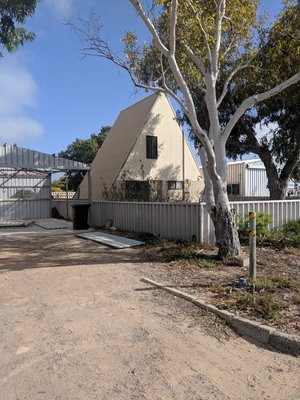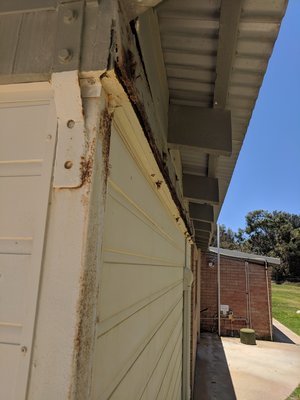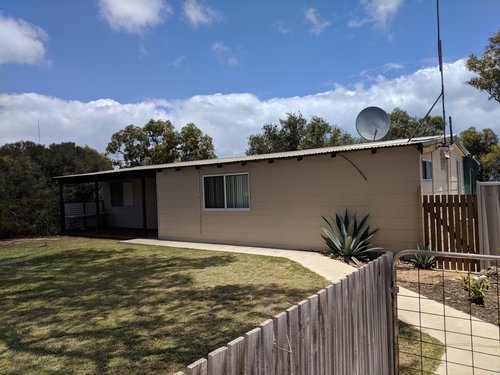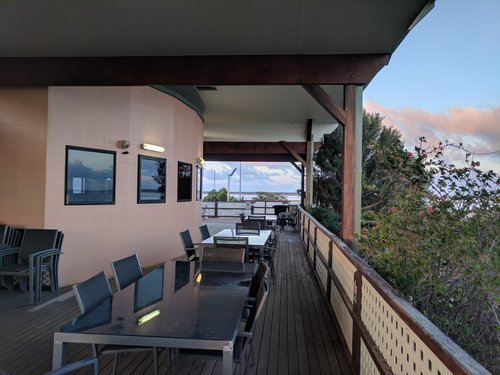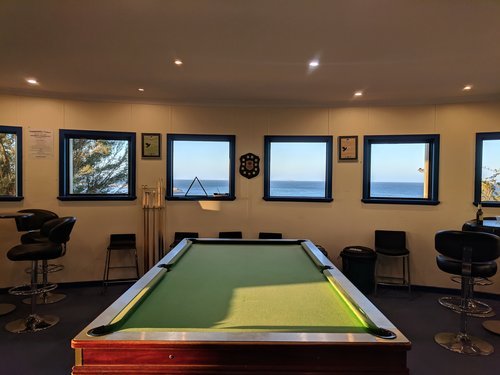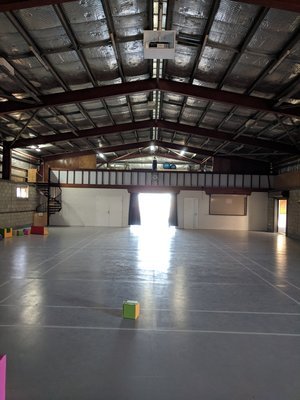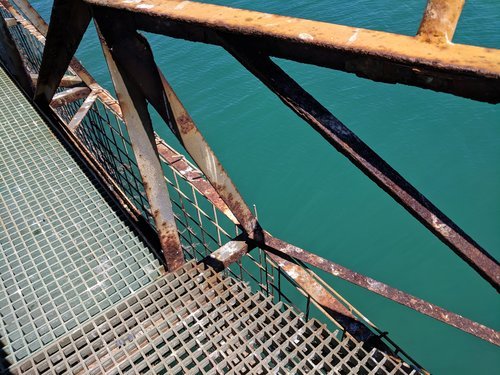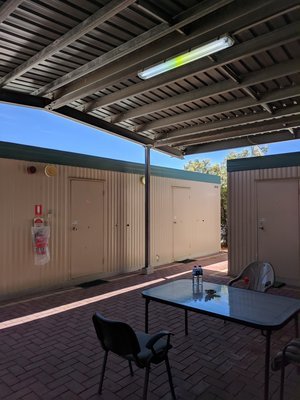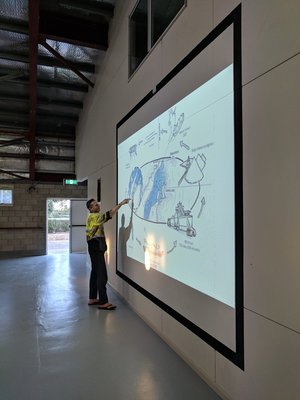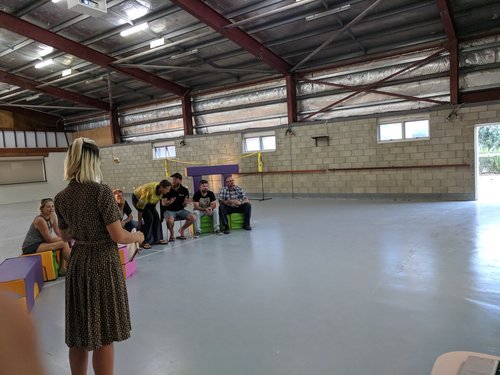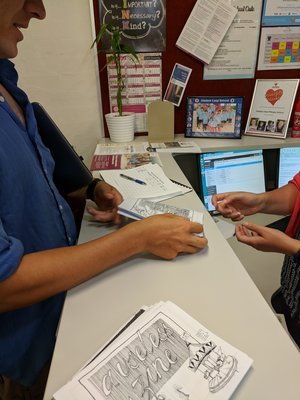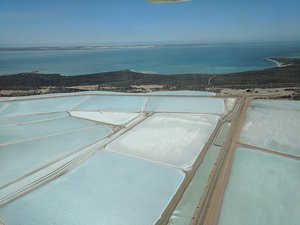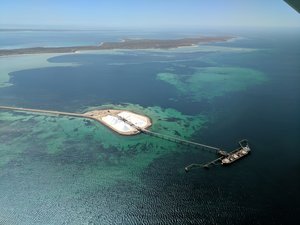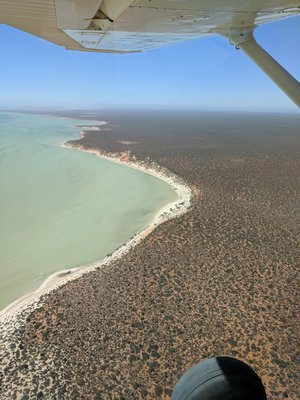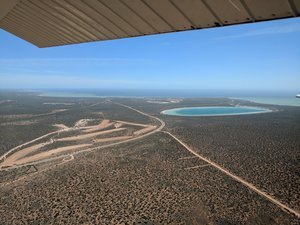The Grand Section Guardian #019 - Stop 019 Useless Loop/December 15, 2017
A northerly blew as we approached, perhaps that should have been a signifier that yet again our expectations were to be blown apart. The rest of our time there, the prevailing southerly blew. Feel good mining, wind and tidal power. The town has a feeling of impermanence, and the pull of the place is palpable.
Place
Wednesday 15th – Friday 24th November 2017
A completely incredible prospect, nestled in the Shark Bay World Heritage Park, Useless Loop is a closed town and salt mine run by Shark Bay Resources that exists and thrives on the pristine environment that is the world heritage area. It is at the meeting point of three major climatic and bio-regions. They say here the desert meets the sea and despite it being on the coast, its climate is semi-arid to arid receiving approximately 204mm/year, very different to the other coast in which we are so familiar with. On top of this the place is classed as being in a type two cyclone area. The hot and windy nature of the place is excellent for salt production (evaporation) but means that the community hall is engineered like a train bridge!
Here the place and industry is the clear driver for inhabitation. The Shark Bay World Heritage area is home to 12 species of sea grass (17% of the worlds known species - from Dr John Statton's research) which form a crucial part of the areas ecology. Sea grasses are the favoured food of Dugongs, in fact 12.5% of the world’s Dugongs live in the area (all 10,000 of them). Sea grass also catches sand and particles as well as providing a habitat for smaller sea life. This builds up over time creating banks of grass and matter, slowing tidal movement and creating “super-saline” environments as the water in the bays cannot mix as freely with the open ocean.
The water in the Useless loop bay is 1.5 to 2 X saltier than the open ocean. Perfect for salt production. The bay directly to the west of the town of Useless Loop once acted as a natural inlet system where now being a sequence of ponds, increases the salinity and hence density of water. This has now been dammed off with sea walls from local rock and pumps are used where tidal power was once relied upon, however large parts of the operation are still extremely low tech which is realised through the language used to explain the mining process; ‘grow’, ‘crop’, ‘harvest’. Driven by gravity, water levels, tidal movements, sun and wind, the mine relies on the pristine water and environment of the Shark Bay area to produce the high quality and large growth crystals Shark Bay Resources is known for. This means their salt can be used for a range of purposes and markets, industrial and domestic. Sodium Chloride (NaCl) is actually used as a base product for a huge range of products e.g. Plastics (polyvinyl chloride), caustic soda, sports drinks, paper pulp and fertilisers. We’re told in other parts of the world such a China where air pollution and toxins are high, salt is becoming poisonous and quality degraded. This stuff is a direct reflection of what’s happening in its environment. Remember back to Stop #18: Wooleen, the quality of the product and prosperity is directly proportional to the health of the place.

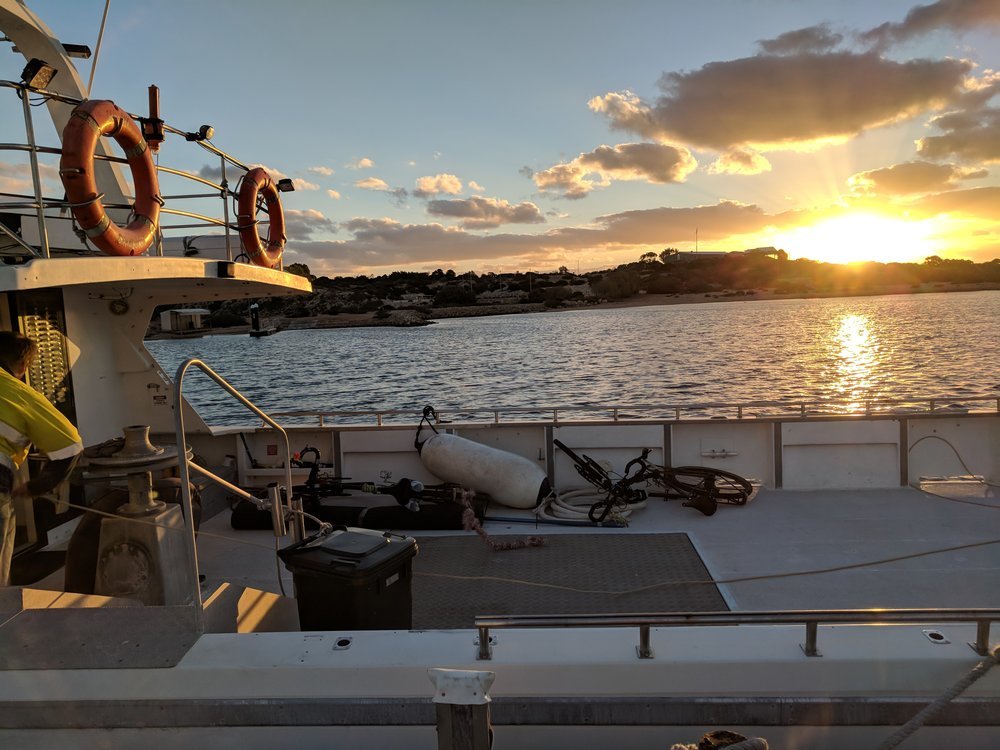
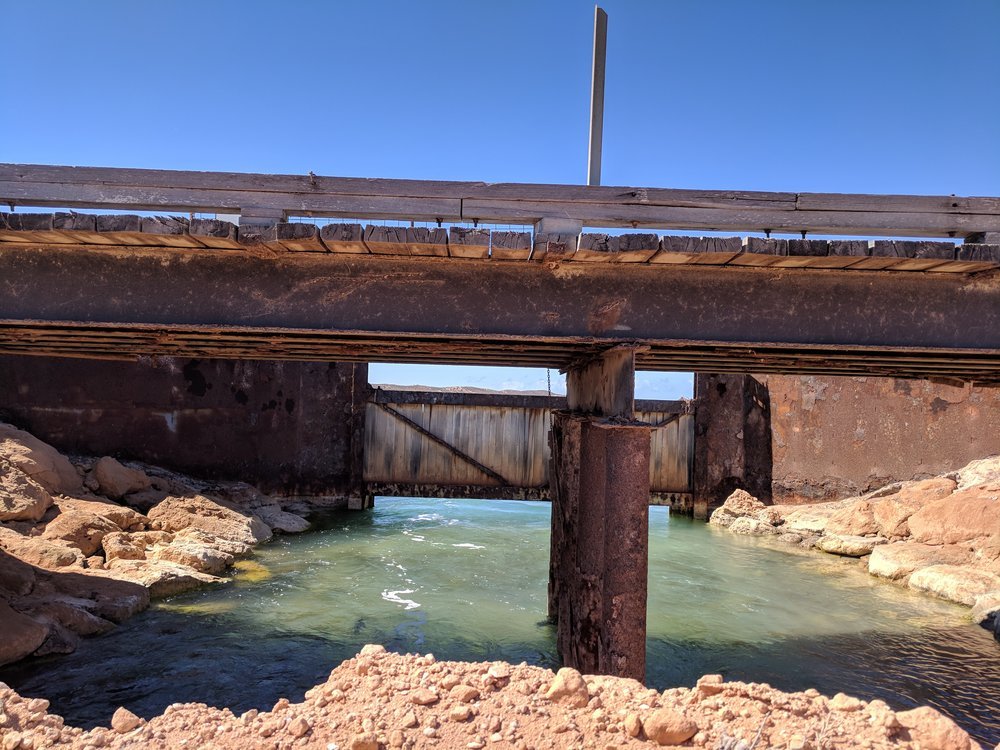
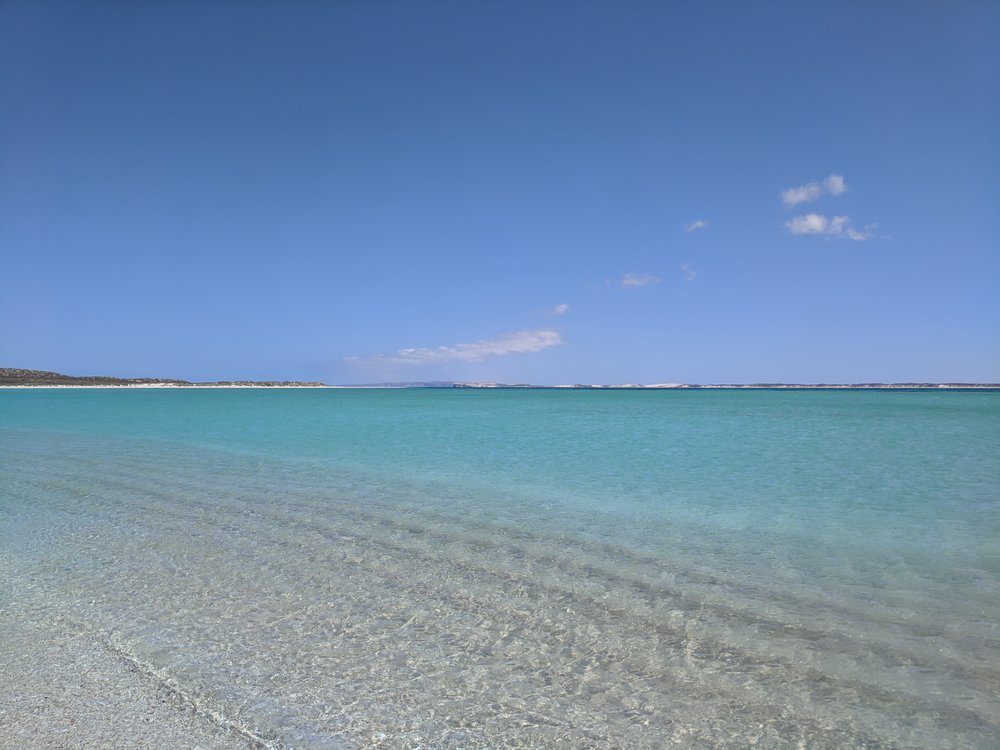
Today the sea walls are favoured fishing spots, with mullet, snapper, squid and some other types of fish that we didn’t pay enough attention to hang out in huge numbers. Dugongs, Reef Sharks, Sea Turtles and Dolphins are common sights from these prime fishing holes.
Lying to west again is Steep Point, the most westerly point on the mainland of Australia. An overwhelmingly powerful place that really feels like you are standing on the edge of the continent, steep limestone cliffs shear off as the wind blows you in gusts towards or away from the churning Indian Ocean. Looking out is the flat horizon, the first time we’ve seen it in nine months, trying to imagine that the next piece of ground is South Africa.
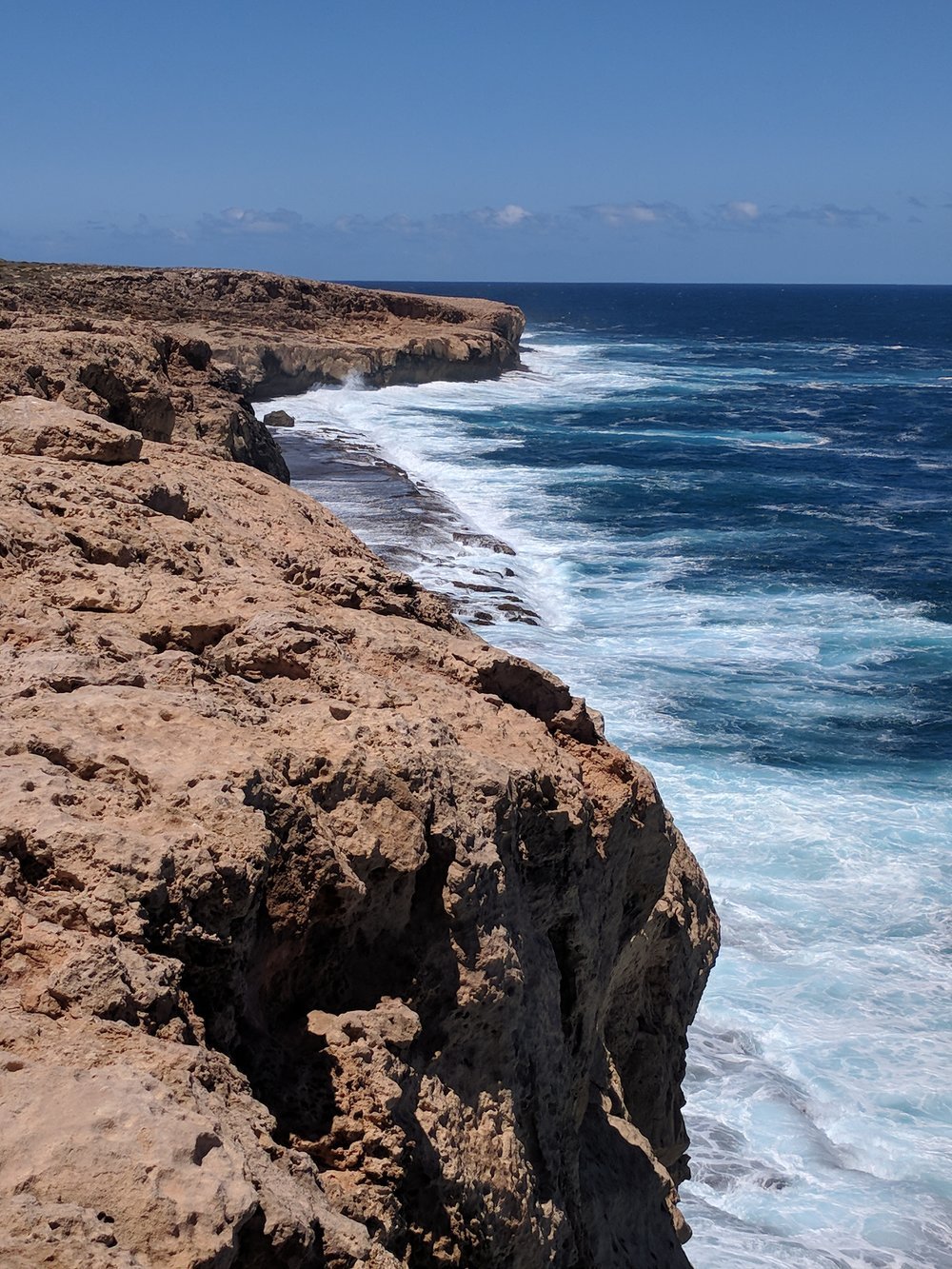
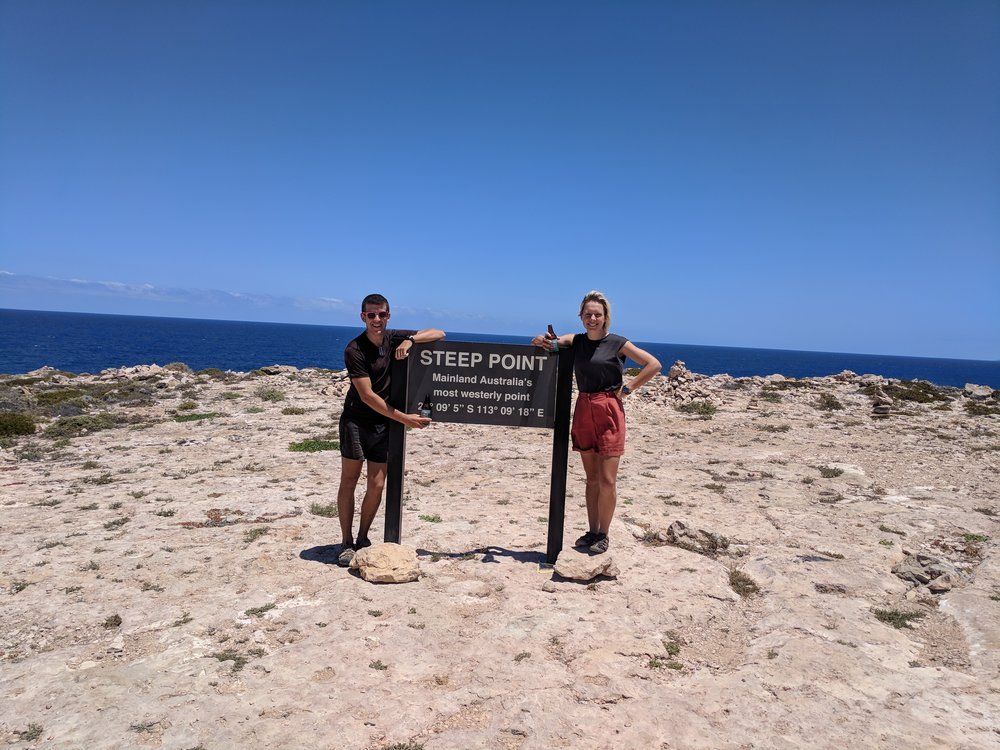
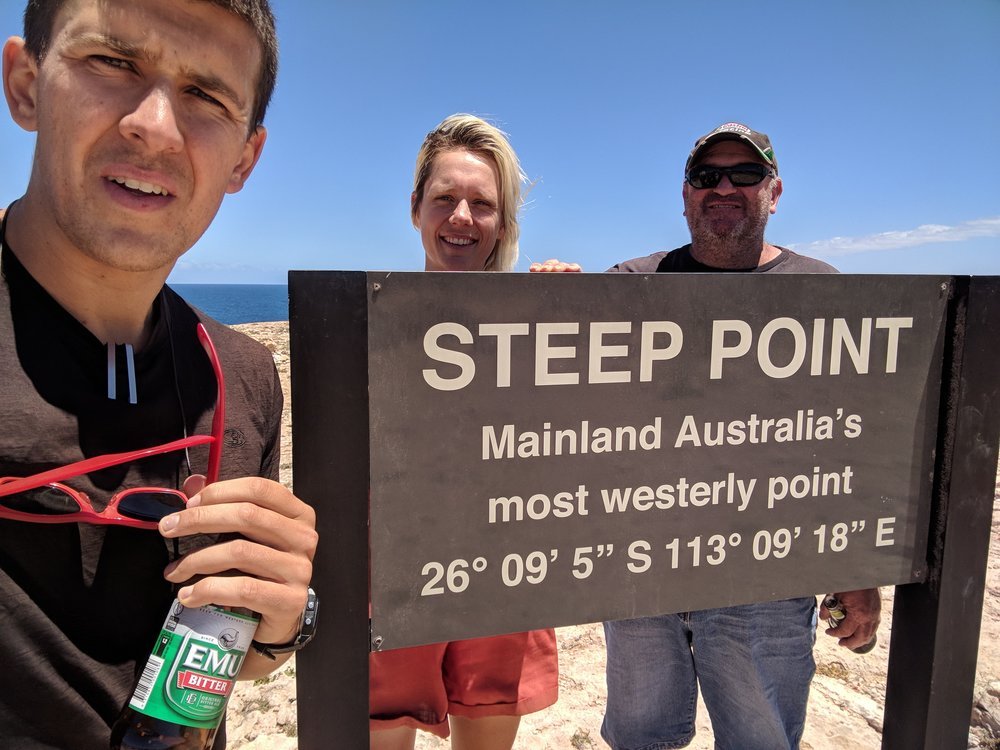
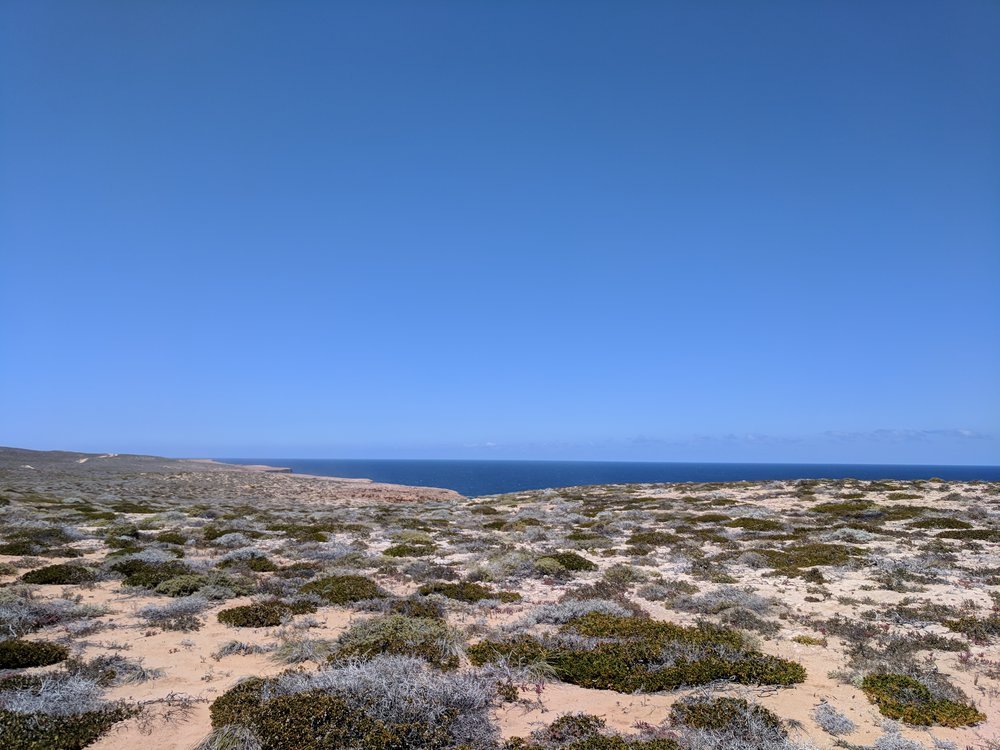
Interestingly the power of the place is not unnoticed by the locals. Those who decide to stay cop the pay cut (salt doesn’t pay as much as coal or gold) because they enjoy the place and the quality of the lifestyle that comes with it. There was an overwhelming sense that this was a special place, and we’re sure the sense of community prevalent here is a result of this.
People
Living in the SPQ’s (single person’s quarters) amongst the mine contractors and single workers and eating alongside them in the mess we were grateful for the opportunity to experience the real thing, rather than just study it from afar. One of the most valuable things we came to come to learn of was, the routine of the mine and hence the town too. Understanding the workers routines, which dictate the use and inhabitation of the spaces in the town.
Phil (Town Services Coordinator)
We tried to make contact with the Shark Bay Resources crew through contacts online and waited months; we had almost come to the conclusion to disregard Useless Loop as a stop. Then the “High-Vis Fairy” came into our email thread and had us organised to arrive, stay for the week, eat and get out of there in a short few emails, we were quite taken by the man’s ability even then. Upon our arrival we came to experience in flesh Phil’s ability to stretch his attention over the plethora of roles that are demanded of him.
Phil has worked in mine camps before with his expertise in the building of mine camps, and as many of the other locals was acutely aware of the beauty of the place. His role at Useless Loop was to ensure that the town ran smoothly. He had to ensure the buildings (all owned by the mine) are well looked after, the shop has stock and staff, the tavern is ready for thirsty miners, dinner comes out on time and there is enough grub to go around and to rescue any emergencies or unplanned scumbags who come to stay. One morning we worked at a table in his office and were exhausted by the sheer number of call outs he had to attend to such a variety of circumstances. We will just stick to architecture thanks!
Phil was kind enough to give us a tour of the town one day (after knocking off), pointing out the plans for refurbishment, new houses, knock-downs, recently completed Reno’s, community spaces and his most hated buildings in the town (which were obviously the ones we were most drawn to, stupid architects). Phil’s ethos is to repair before replace, years of organising maintenance and knowing how materials weathered and what was needed to get the most from steel, timber or fibro was furiously scribbled down by us two as we tried to absorb as much knowledge as we could. The first time on the trip where maintenance was seriously considered. Owen is currently creating a shirt that reads: “MAKE MAINTENANCE SEXY”... (please email to place orders...)
Glen (Mine Manager)
The big boss, Glen, nine weeks new around town is in charge of the whole show at Useless Loop. We had heard about Glen and Phil was organising a meeting for us. Described to us (by someone we can’t name) as a Byron Bay hippie, Glen smashed our pre-conceptions way out. By chance, we caught up with Glen over dinner at the mess one night. Instantly understanding the trip, not just what we were doing but exactly why we were doing it, on a level that cannot be explained but is a connection that has happened throughout the trip with only a select few people. Glen has worked in mining for a long time, as well as trying to operate his own off grid farm to be fully self-sufficient before letting it go to become an ad-hoc nature reserve. Highly intelligent, Glen is well aware of the contradictions that are part of life and acknowledged that a radical change in the way we live had to happen for any chance of ‘sustainability’. Glen applauded us on going ‘outside’ and looking and thinking, saying “I’m proud of you” which left us all warm and fuzzy and sort of awestruck as to whether Glen was prophetic, knowing what we would get out of the trip more than we knew. His plans are now to double the amount of salt produced from Useless Loop, all to do with efficiency of management and processes, not more staff or ‘stuff’. Thanks Glen.
Jeremy (Contract Operator)
Off a paved courtyard over two levels are 24 x 10.7 sqm donga bedrooms with ensuites, more commonly known as SPQ. This is where the self-titled shit kickers hang out. The contractors are the last to come and the first to go as the mine’s production varies. We lived in these with Jeremy in the SPQ’s where he was quick to jump on the website and our social media feeds to find out about the trip and where we’ve been. His good sense of humour and larrikin behaviour always made our afternoons a delight. Jeremy became our biggest advocate at Useless Loop, telling anyone and everyone about what we were doing with enough embellishment and humour to make it sound interesting and worth looking into! Jeremy is emblematic of many of the contractors and some of the full time staff. With three kids at high school Jeremy does his stints working at “the Loop” (for up to months at a time) while his wife and family live in Geraldton (five hours away). He too has been checking in on us ever since, especially on the hot day riding.
We posted an image from the air and Jeremy replied with this... so good!
Cam (Ponds Supervisor)
Cam by all accounts was a really nice guy and so when we met him it was no surprise that he was in fact, a nice fella. Intelligent, patient, up for a laugh (at our expense with us tasting The Bitterns) and willing to entertain our desires to see how salty the salt mine water actually was, Cam showed us through the whole production process of the mine. Cam is the other demographic of the mine, young with a wife and young family, one of whom has just started at the primary school. Already here for six years Cam said he has no plans to move until his kids have to go to high school (the reason why so many families leave), he started out as a bricklayer but the power of the place at Useless Loop drew him in and he is hooked. Another victim of the incredible fishing, camping and swimming.
Stuff (Architecture)
It’s an interesting one. Seemingly temporary forms of inhabitation, yet the time frame the buildings and structures have been and will be there for speaks more of permanence. Committed to remaining a ‘closed residential site’, the town has been so since 1967. The evolution of the place’s buildings have been interesting and almost proportional to the change in scale of the mine, initially starting as a solar salt ‘farm’. People lived in caravans and shared communal amenities with women rotating the role of cook for the employees each day. Some had three caravans at times, one each for the children and one for themselves.
As the scale of production grew, so too did the evolution of housing. Some of the original buildings of concrete tilt up still exist today and seem to be holding up well. That continues to be the fashion; transportables. Fully equipped steel frame houses arrive in three modules trucked up from Perth or Geraldton. A slab is poured on the ground, the modules are put in place with no consideration of passive design principles or orientation (other than the view), hooked up with services, and families move into them. The town plan started with a backbone (Salina St) and the growth of the town has seemingly been haphazard.
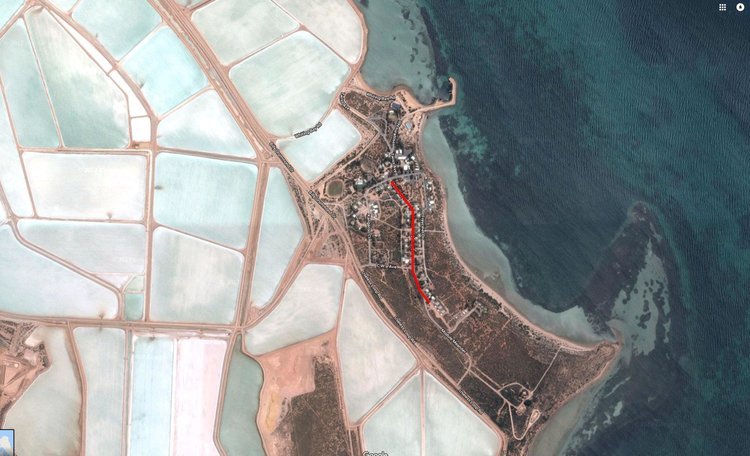
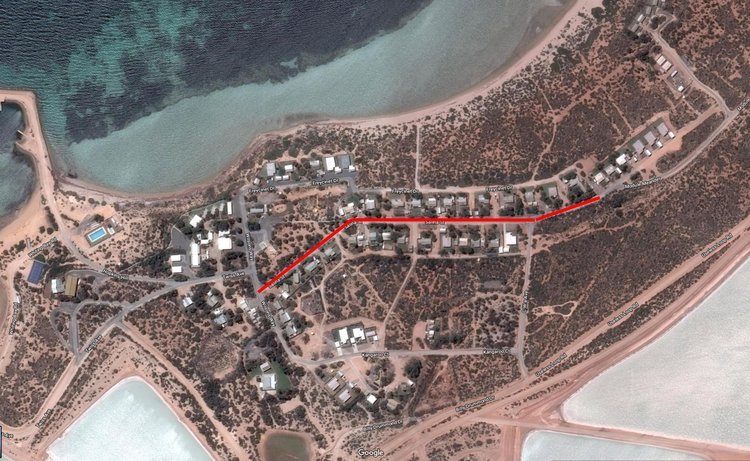
Dongas (as we continue to see) with an average lifespan of 25 years are the economical and easy option of inhabitation with the first lot being installed in 1999. Used for contractors and overflow they are compact with no communal social spaces at a total of 10.7 efficient sqm per room. The SPQ’s where we were staying were apparently the prestigious kind as they were arranged around a very generous undercover paved area. The odd chairs and tables littering the area comprised the only break out space for the contractors, sometimes staying there for months. In questioning the lack of a formal social space for the workers; e.g. lounges and facilities, there was a divide. Some would prefer a space and others not because it makes them stay up too late for the long 12 hour cycle of 6am-6pm.
Interestingly, focus has now turned to maintenance rather than replacing with new transportables. A new four bedroom build including services costs approximately $650,000, $350,000 for a new three bedroom home, yet a full renovation of three bedroom costs $85,000, ensuring longevity of materials and infrastructure, cost saving and less waste to landfill.
Possibly due to the nature of mining, boom and bust as well as the economic rationalist approach of big business the town has never had a definite future and as such it is uncertain how long the architecture will be needed for. Useless Loop as a town has also never had the need to promote itself to patrons which has been the driver for much of the permanent habitation we have seen across the continent. The main purpose of the residents was and still is to mine salt, grand architectural gestures were unwarranted and unrequired. However the low tech nature of the mine and the product being a ‘base mineral’ means that it seems unlikely that the mine will become useless (…get it?) for a long time yet. Perhaps longevity is the smarter and cheaper option?
Another aspect of the ‘architecture’ is the infrastructure of the salt mine itself. Local dirt and quarried stone walls create ‘bars’ that dam the ocean and increase salinity, fitted with flood gates to control water levels and move increasingly salty water through the process. A 30 km ‘flume’ is an earthen, timber and occasionally asbestos open drain that gravity feeds the water into shallow ‘condenser’ dams that allow sun and wind to increase salinity and ‘grow salt’, this is roughed up by a grader and then picked up by a harvester, put into a semi-trailer, dumped into a washery, washed with sea water then conveyor belts take the salt out via a sea wall to a natural island turned stockpile. (Look at Mining processes page in the zine for more info) From here it is pushed onto another conveyor belt by dozers which take it to the ship. The six year old ship loader cost 30 MILLION and is already showing significant rust, even though maintenance is carried out religiously, the seriously salty coastal conditions make this a constant battle. All in all though pretty low key for an international mining operation. Aside from the mechanical impossibilities we thought shiny stainless steel graders would be a lovely shiny addition to the salt mine as the current graders look decades old after only a few months due to the catalyst and accelerant which is the chloride part of salt.
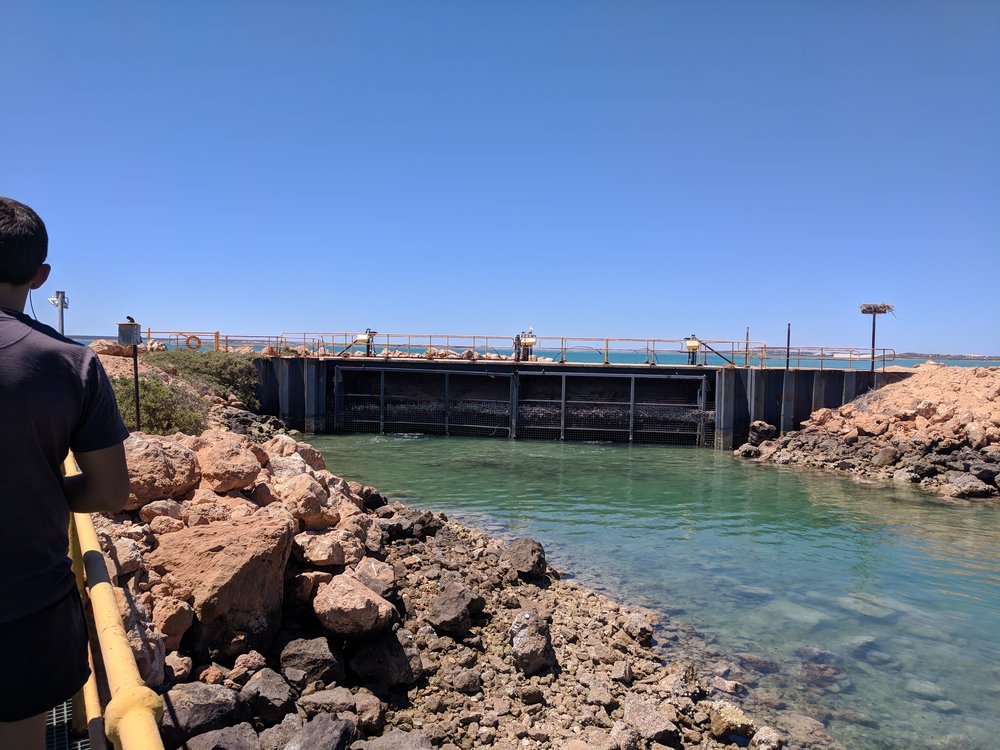
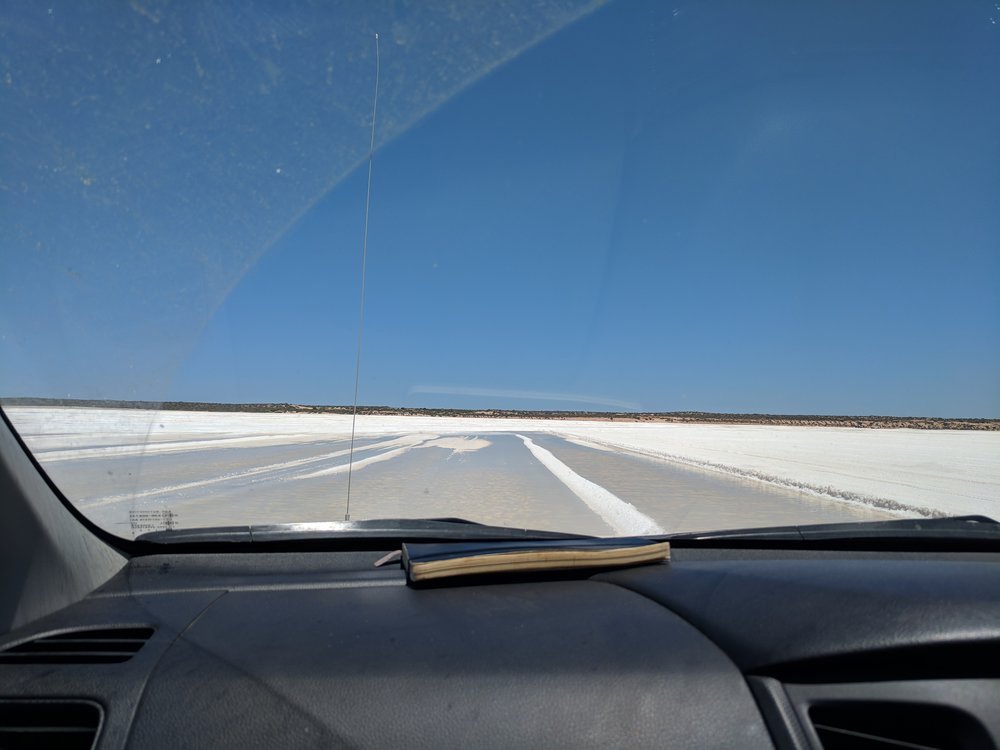
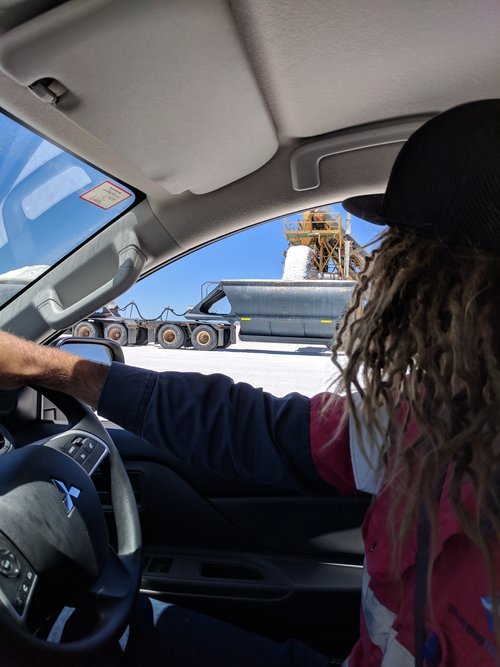
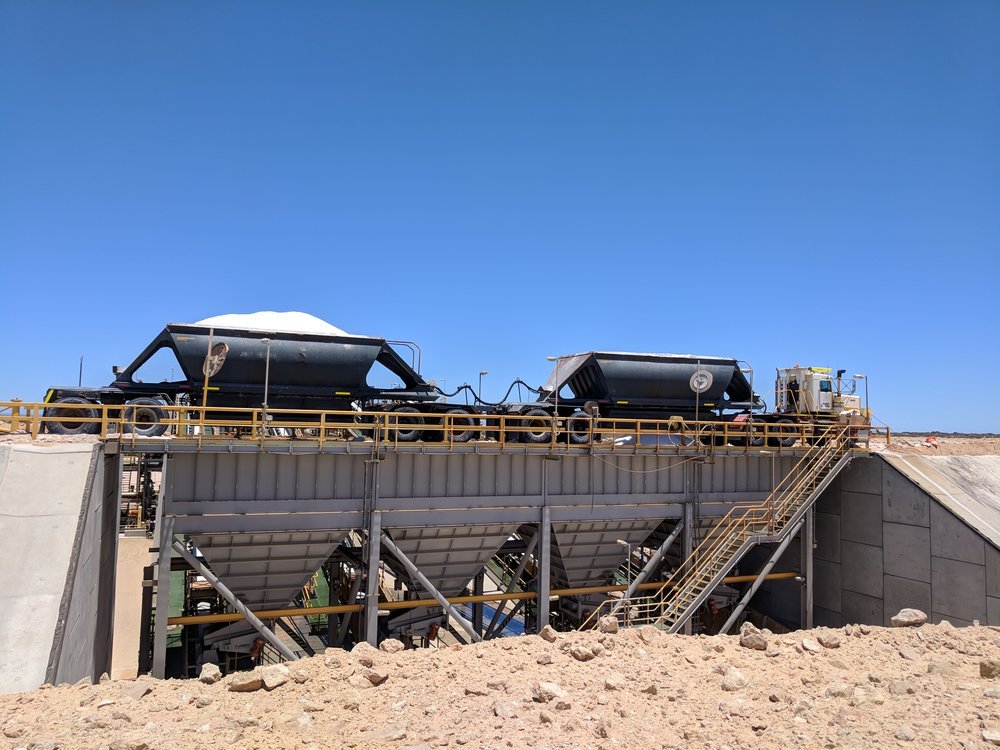
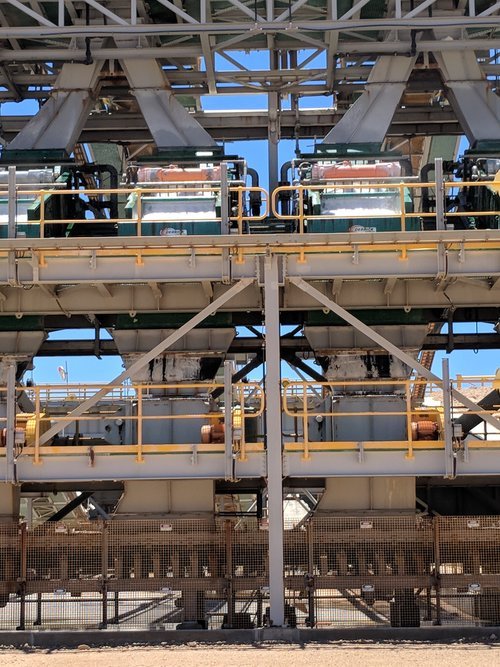
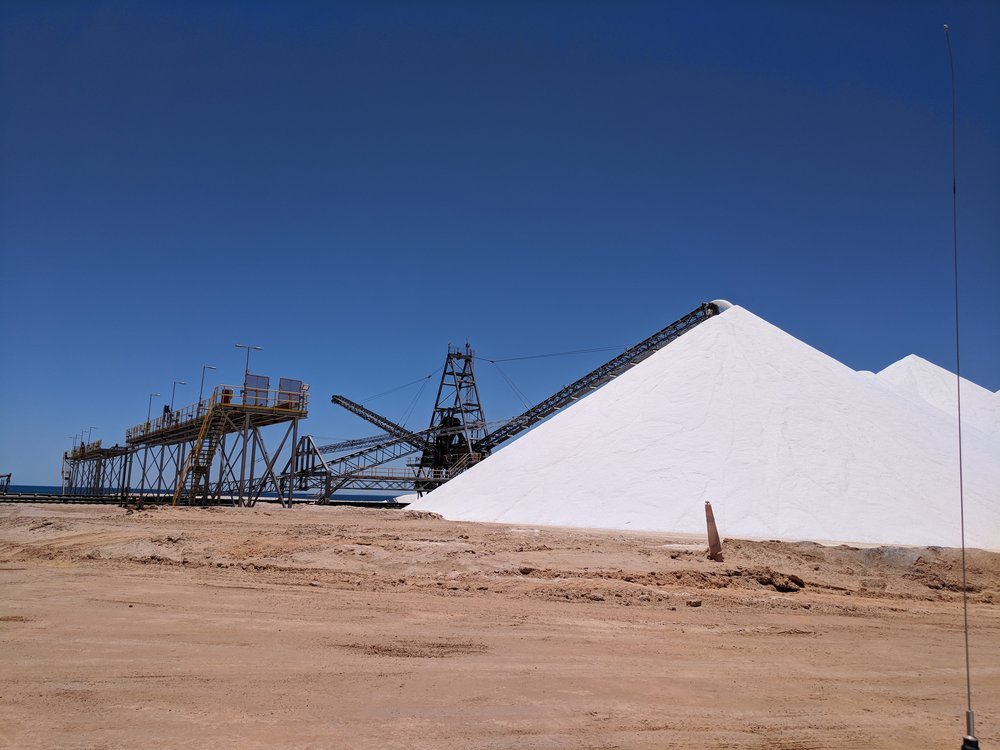
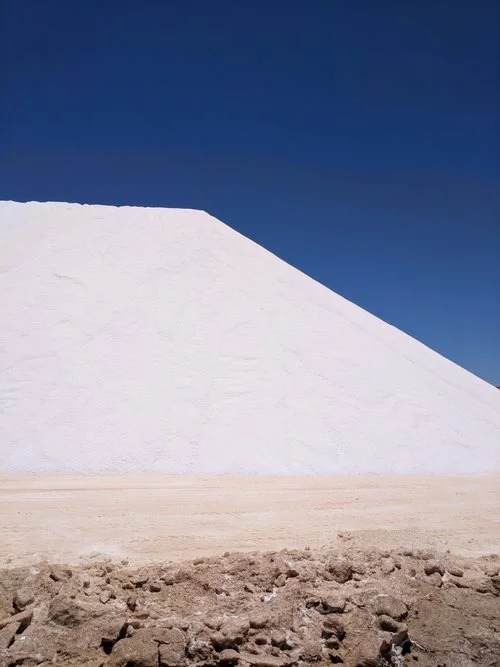
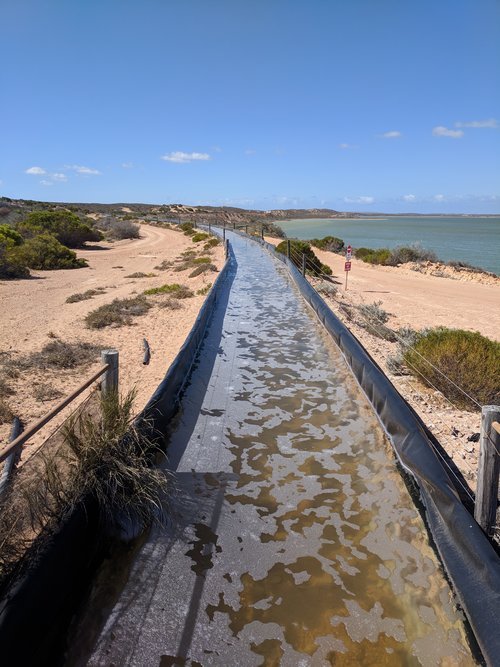
Exhibition
Tuesday 21st & Thursday 23rd November, 2017
Earlier in the week we had the opportunity to work with the Useless School (got to make the most of the name). As usual challenging our techniques and modes of communication for Day One, we made a cartoon instructional of ‘How to Map Sun’ and left it with the senior kids to carry out and collect the data for us. Day two we returned and asked what they had learnt. All answers were observations made by students, exactly our intention – to encouraging seeing through a new perspective not just about the nature of the sun.
Having the entire school (age’s 5-12years) of 15 kids proved quite challenging in terms of tempering the content to be appropriate for both age brackets. A presentation of photos and diagrams on the whiteboard made the trip a tangible entity for students and a building exercise with good ol’ cardboard trying to block sun and create a shady space to sit gave the older kids an understanding in practice. We had tears, laughs, screams, fights, cooperation, delegation and incredible ideas and autonomy. Kids just seem to work it out. Younger kids who lost interest instead grabbed textas and decorated the inside with ovens and TV’s, the outside with non-cut window holes and gardens while the older kid’s problem solved the building, taping and engineering of structures. We were highly entertained and moved by the kids’ freedom, creativity and looseness, “We need to get some of that back”, we thought.
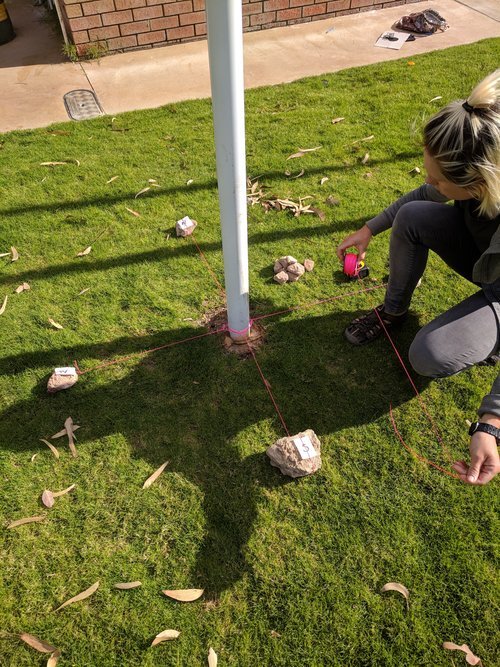
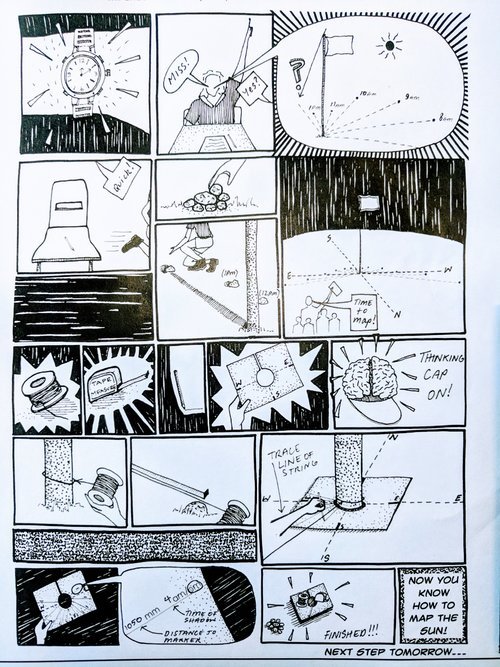
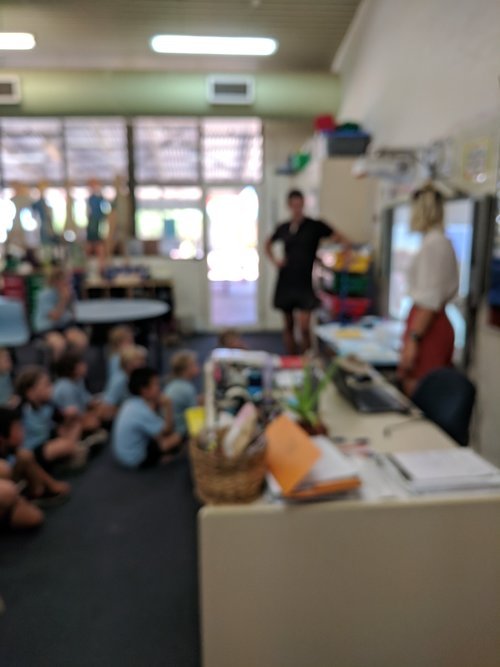
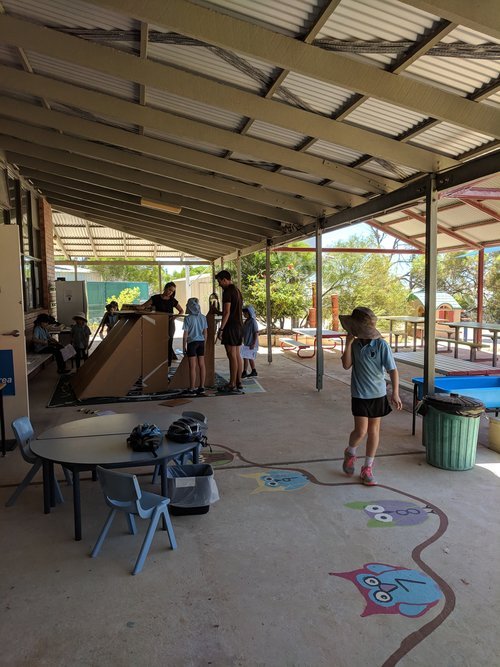
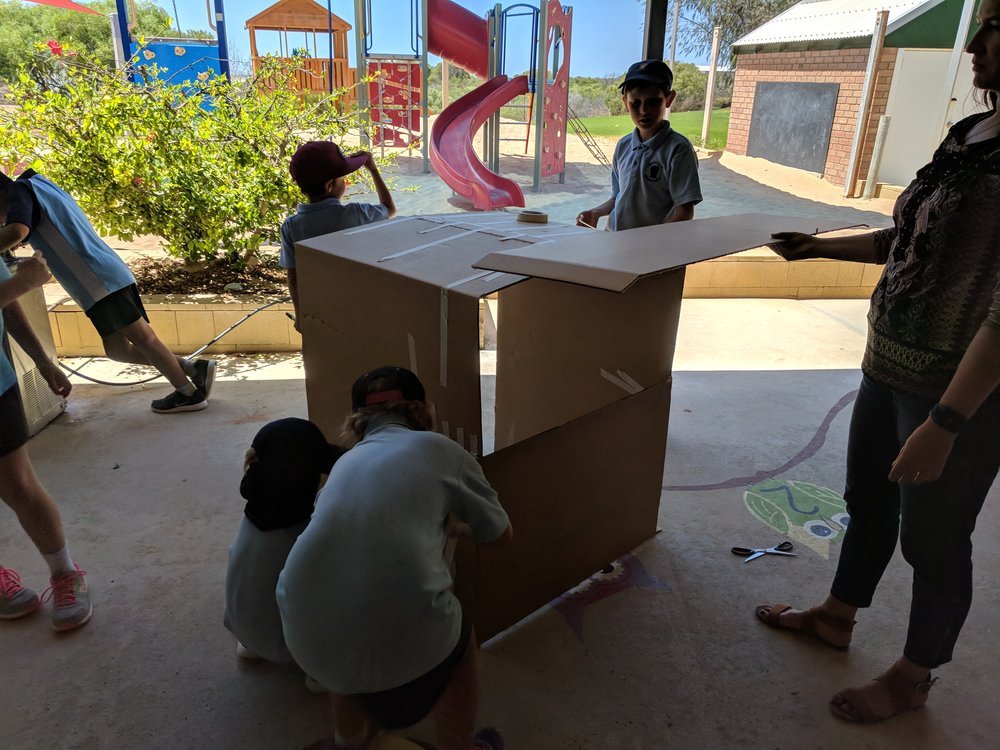

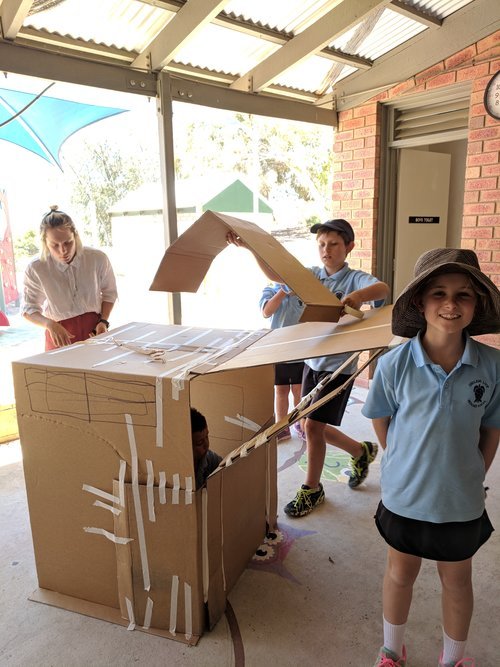
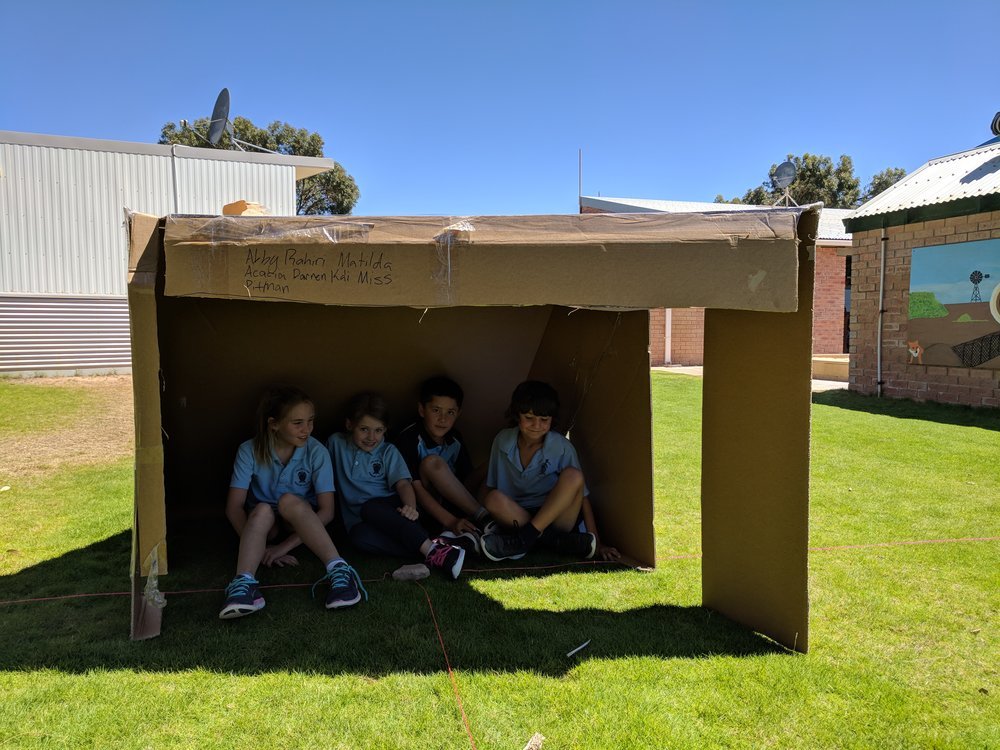

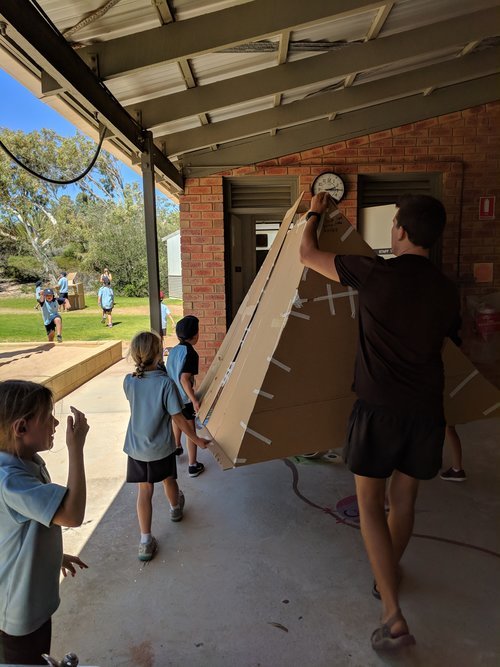
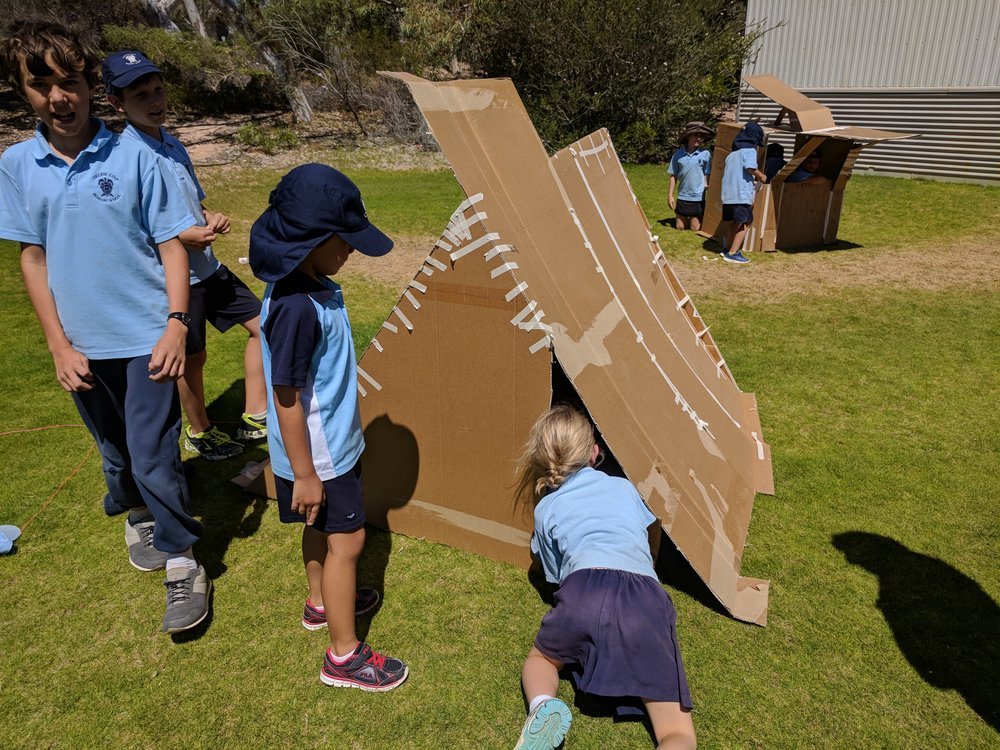
Thursday evening we presented to the big kids of the town, the adults. Advertising sent out via an email community notice. Presenting in the cyclone rated and beefy structured community hall which has a gym, projector, sound system and kitchen all available for residents to use, it was the first time on the trip we made and presented a PowerPoint. We were meant to start at 5:45pm but a contracting crew had promised to come and had asked us to wait till they had showered (they had been drinking beers all afternoon so we thought it a wise option). The presentation was well received and discussions continued into the bar afterwards. Meeting some more fantastically wise folks in the process, we were hugely grateful.
Suggestions
Observations and suggestions, as to what stuff works in Useless Loop.
Add rainwater tanks
Place services above ground, soil conditions degrade pipes and infrastructure
Raise buildings for passive cooling and access to services
Timber should be painted
MAKE MAINTINENCE SEXY
Social spaces are abundant but without programming can be useless
Face the long side of your building east and west, with deep verandahs the whole way along to capture southerly breezes and to have a spot to sit in the morning or afternoon sun in winter
Shade to the west
Corrugated iron, fibre cement and concrete appeared to be the best performing materials
Dongas come on chassis. Look after the chassis and you look after the dongs (thanks Phil)
Maybe turn the 30 km flume into a fun kids ride
Make the most of the incredible views at Useless Loop with windows that take small snapshots of it rather than one big expanse, that’s what verandahs are for
The better the environment the better the salt…get that sea grass growing man
In-between (Useless Loop to Wooramel Roadhouse)
Friday 24th November - Friday 01st December
We were lucky enough to be offered a flight from Useless Loop to Denham and so our bikes were shipped over on the pilot boat previously in the week. The mail plane that we hitched a ride on comes three times a week to Useless Loop, four seats or six depending on if it is the big one or the small one! We got the small one which was incredible. A bird’s eye view of a place allows you to understand a place in a new perspective. We had come to know the place on the ground plane, we then came to understand its overarching geographies, large scale planning and geological connections. What a treat!
Flying over the country to Denham airport the scrub dotted red dirt is intersected with pools of turquoise and cutting lines of bitumen, we saw where 'the desert meets to sea'. A short airport transfer later with some knowledge from the local grandmother and grandson who picked us up, took us the scenic route and dropped us off at “the old pub”. We got our bikes back and booked into the Shark Bay Caravan Park to catch up on a backlog of work and some sleep. Finding a shady spot that was out of the incessant, brutal southerly’s at this time of year was impossible so we settled for the shade only. That wind was really like no other we had experienced, perpetual hat holding required.
We even spent a whole day doing absolutely nothing! Thanks to Von & Ken at Shark Bay Caravan Park, they looked after us and made sure we got out to Monkey Mia despite the howling wind restricting us otherwise to the place.
On the road out of Denham, tackling the ferocious ‘trade winds’ as headwinds, the vegetation seemed to show exactly how to survive out there. Bunkered down, salt tolerant bushes were knee to hip height with only coastal Hibiscus bushes providing shade at a scale we could use.
We were overtaken by a couple we met at Denham, Sandy and Morrrie. They pulled over and as promised invited us in for a cup of tea. A lovely break from the baking sun and usually dirt filled breaks. Filled with tea, cold Pepsi and strawberry wafer biscuits we parted ways but very much in higher spirits.
Shelly beach amazed us, the Fragrum cockle lies in abundance where over millions of years the shells are dissolved by acid cementing them together into a 'coquina' limestone. There it is quarried and used in structures all through the area including Hamelin Pool. The site of stromatolites, the oldest living things on earth! Some have been recorded to be 3.5 billion years old! Holy fuck! http://www.australiascoralcoast.com/attractions-events/natural-wonders-of-the-coral-coast/stromatolites-of-hamelin-pool these apparently could be the answer to new life on other planets, maybe too we could take some ques to apply to resilient architecture ey?
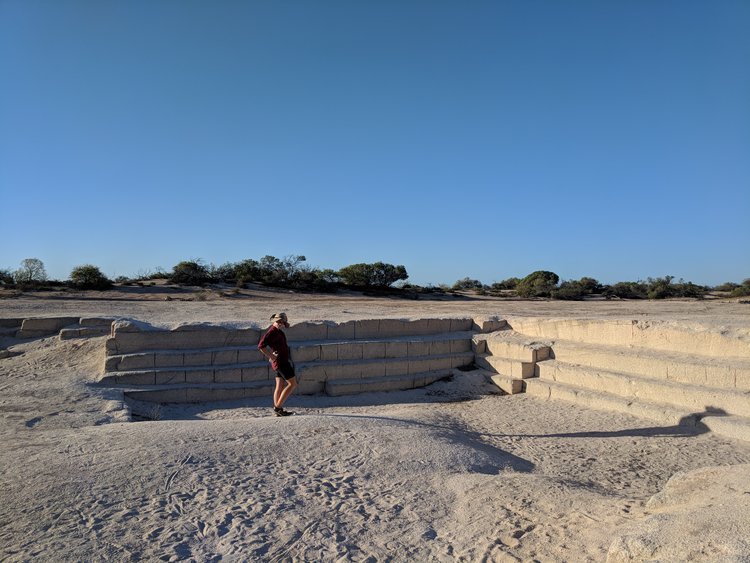
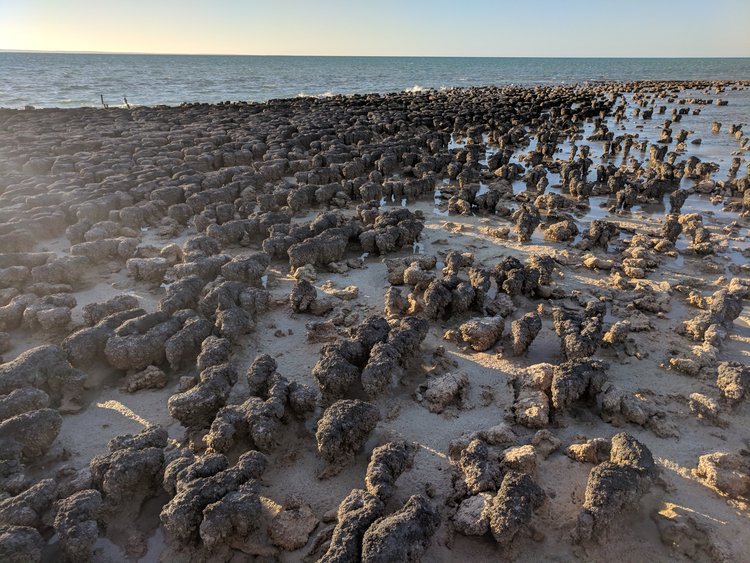
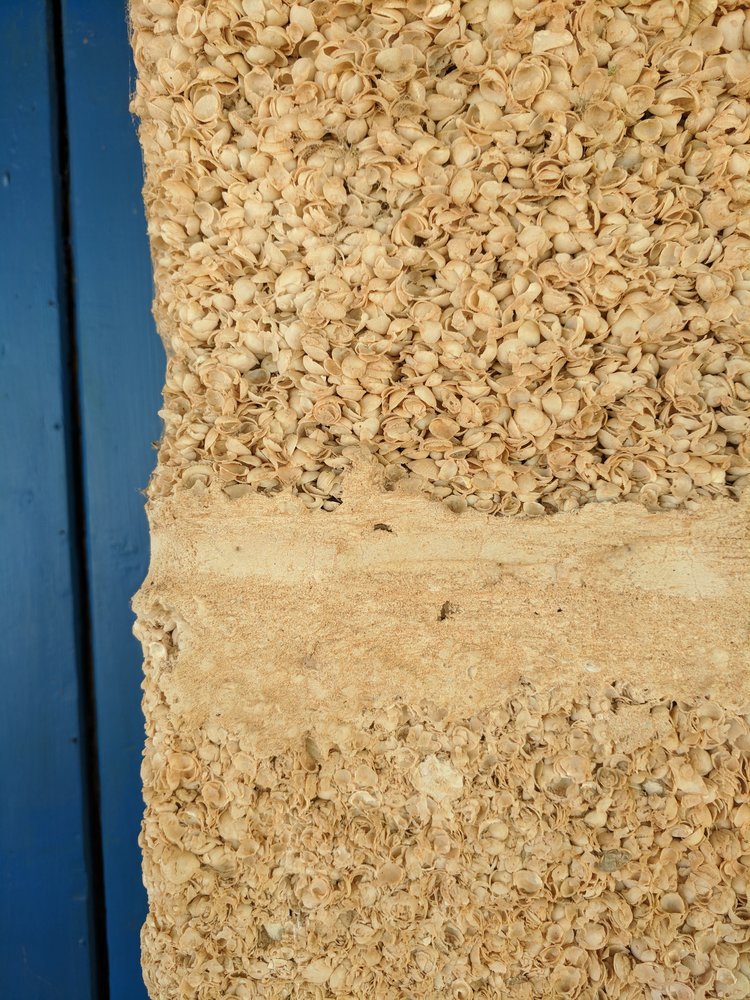
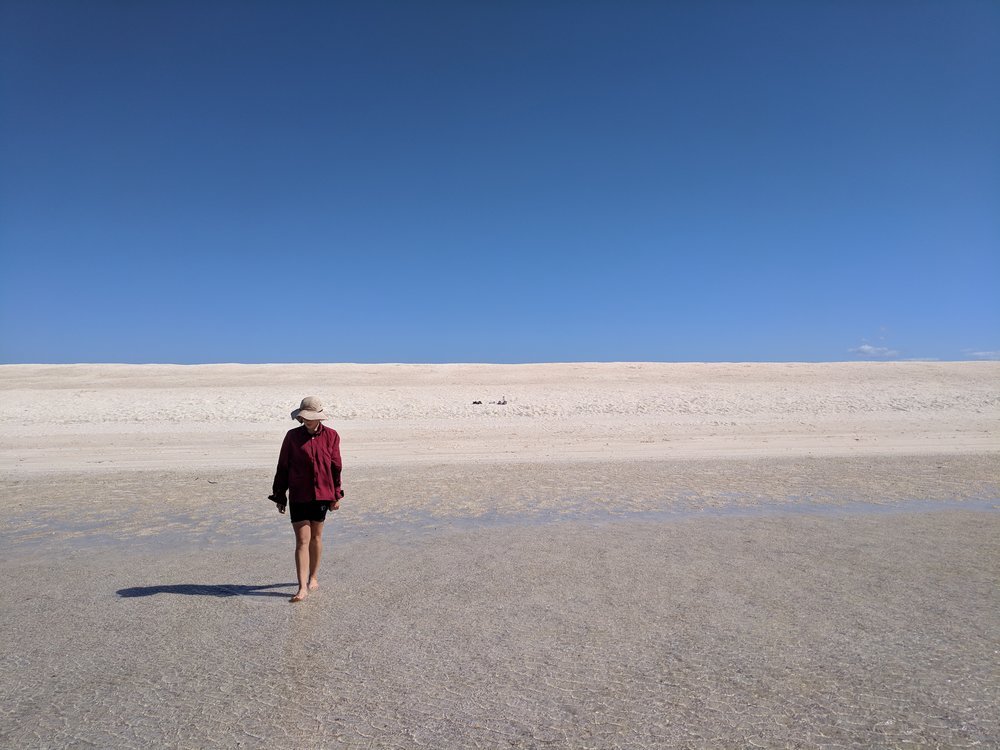
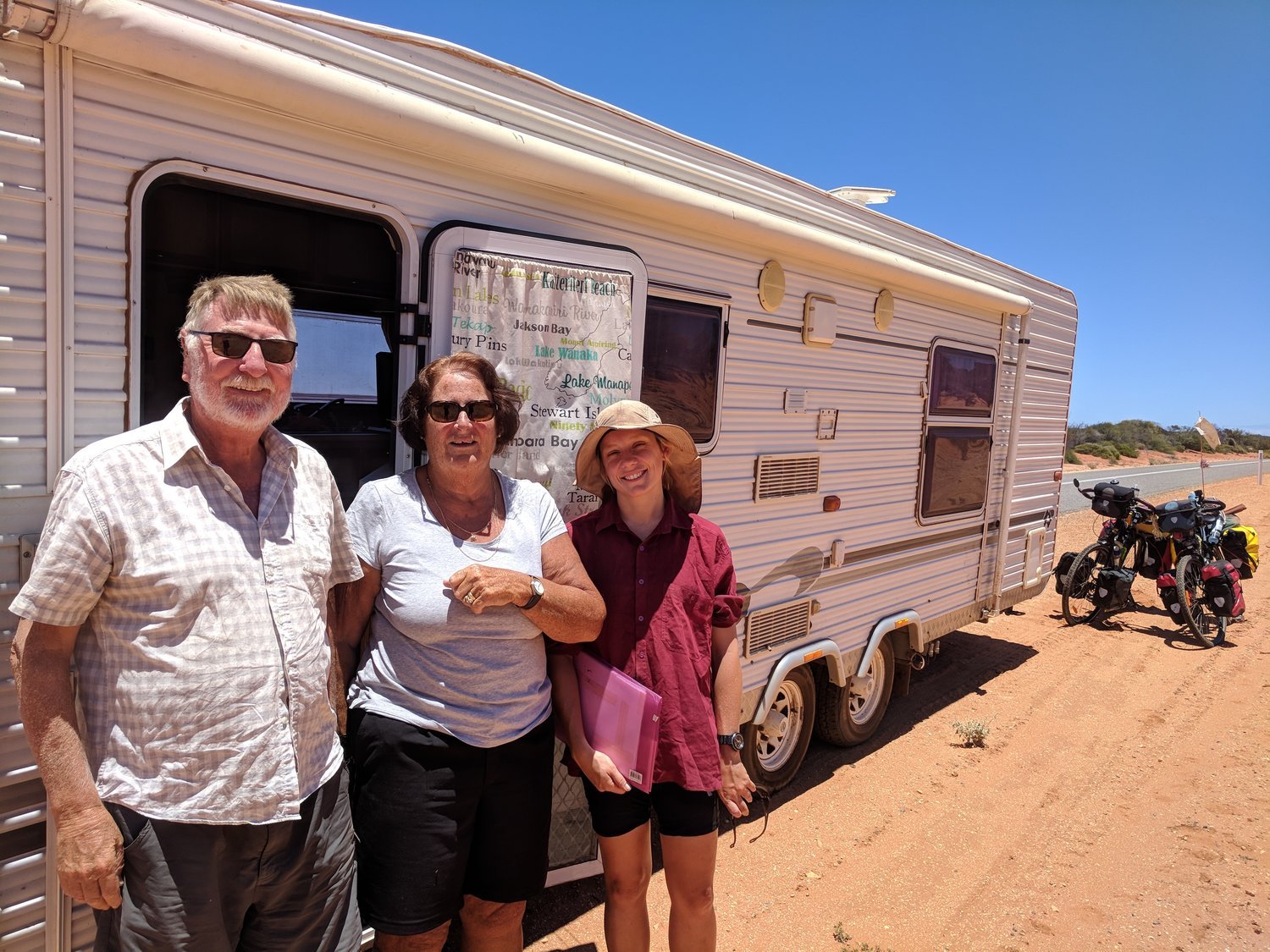
Thankfully at Hamelin pool the road curves east so the south westerly headwind was now blowing in our favour. Here the vegetation too seemed to change, growing in scale, trunk size and range of species, the landscape was more protected by geography from the harsh winds. Stopping at the Overlander Roadhouse again, we cobbled together a few slides to pitch for the next student architectural congress (which we didn’t win, by three votes). Now on to the northward stretch following the coast, we rode on towards Stop #20: Wooramel Roadhouse.
Back into Burr country, but in amounts we hadn’t experienced. Wild Goat’s poo and Burrs were the only things covering the ground plain, it’s pretty clear the problem which faces the barren, denuded landscape and high browse line. Somewhat bitter sweet, Bitumen seems so easy, the road surface from here on out.
The day we rode into Wooramel Roadhouse it hit 43 Deg with the brutal wind persisting. Run by the lovely couple Neale & Margaret actually living in Raymond Terrace for quite some time (an area about 40 mins from our university in Newcastle, NSW), they welcomed us into the roadhouse, slightly confused at the thought of us hanging around for so long. A place of nothing more than a petrol station and stop over Caravan Park out the back, we thought to ourselves that this might yet be our hardest stop. Where is the Architecture? One would ask.
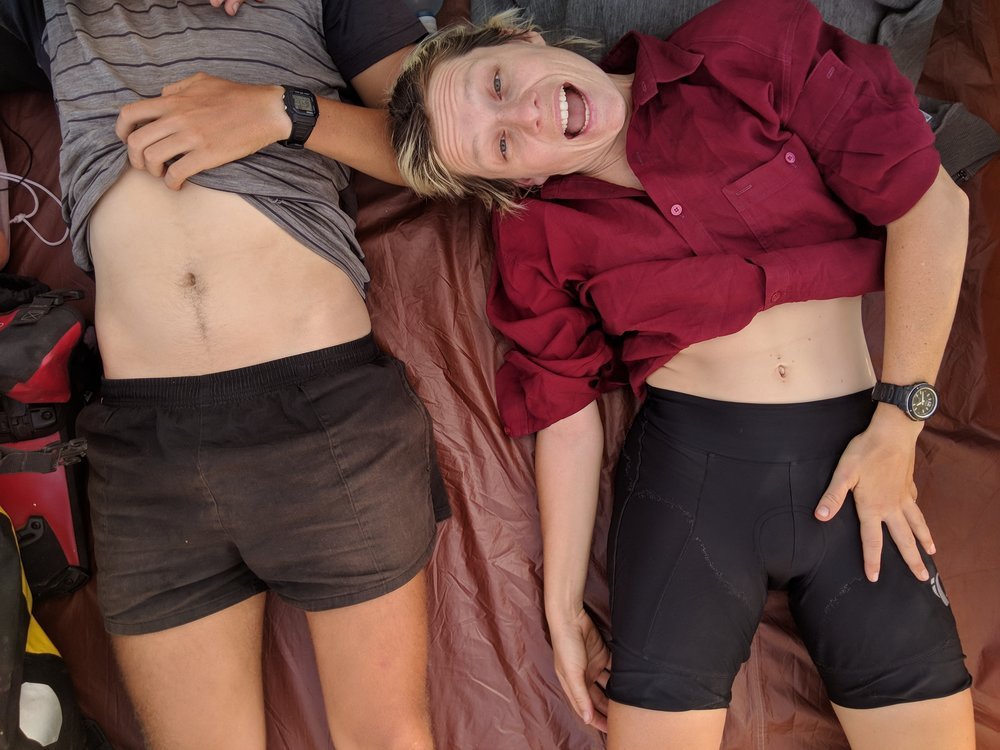
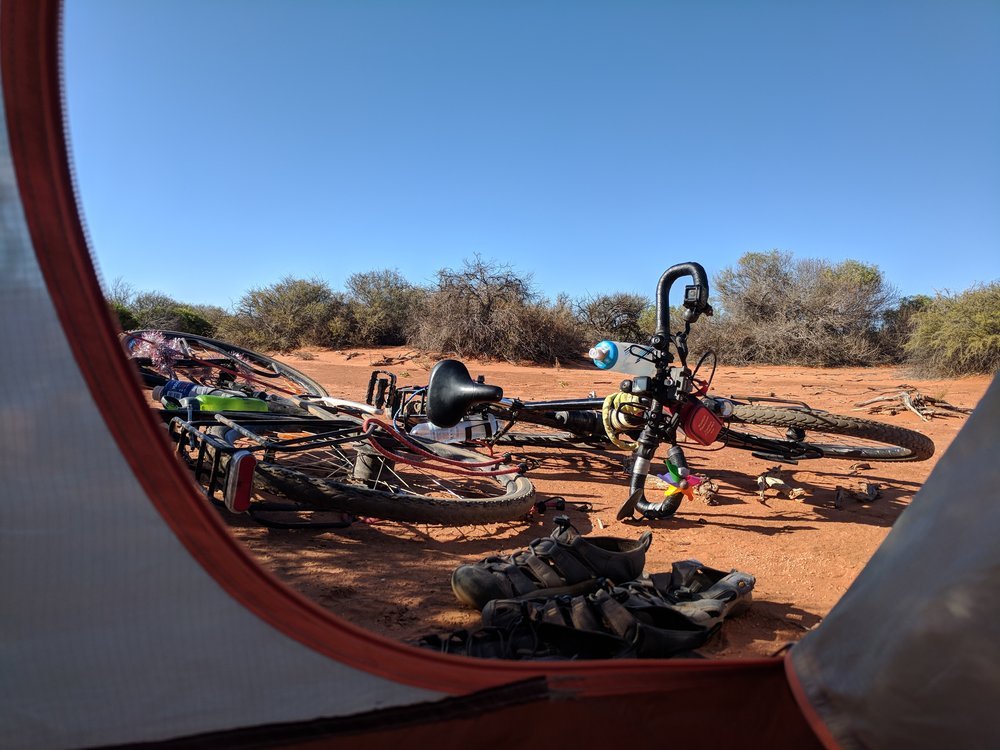
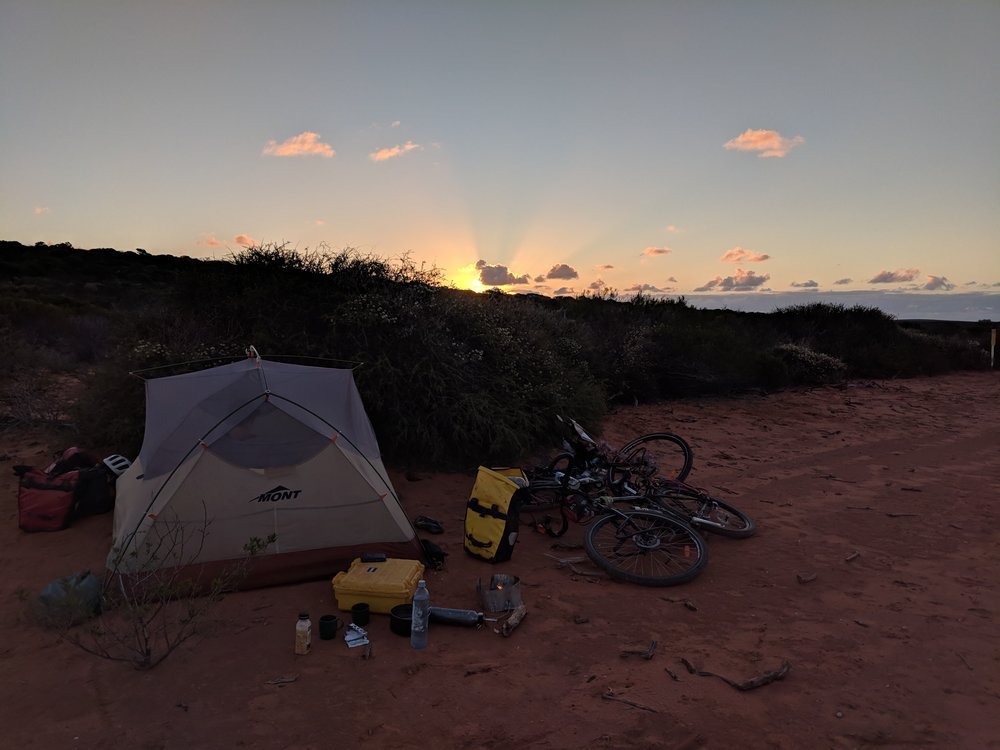
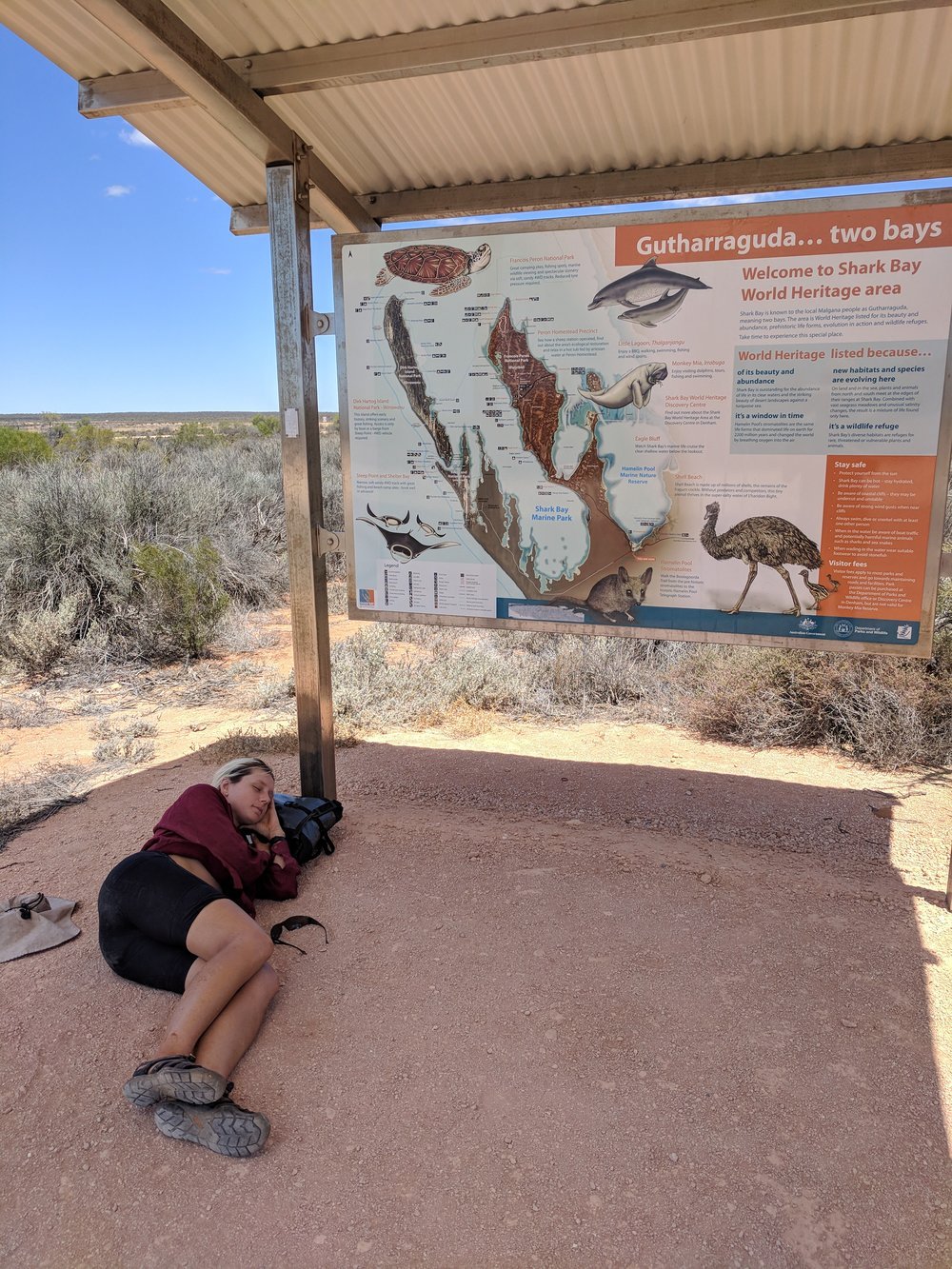
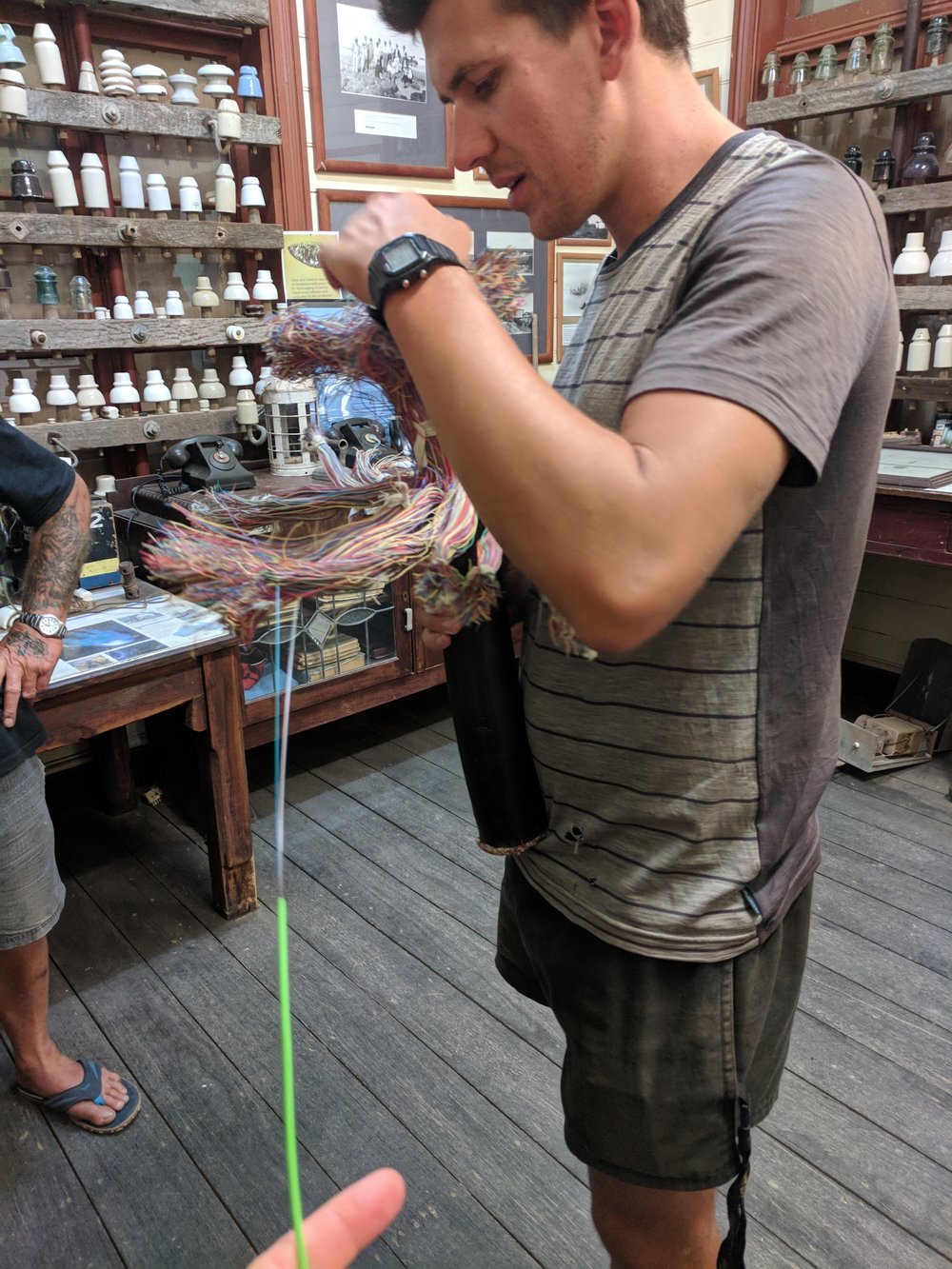
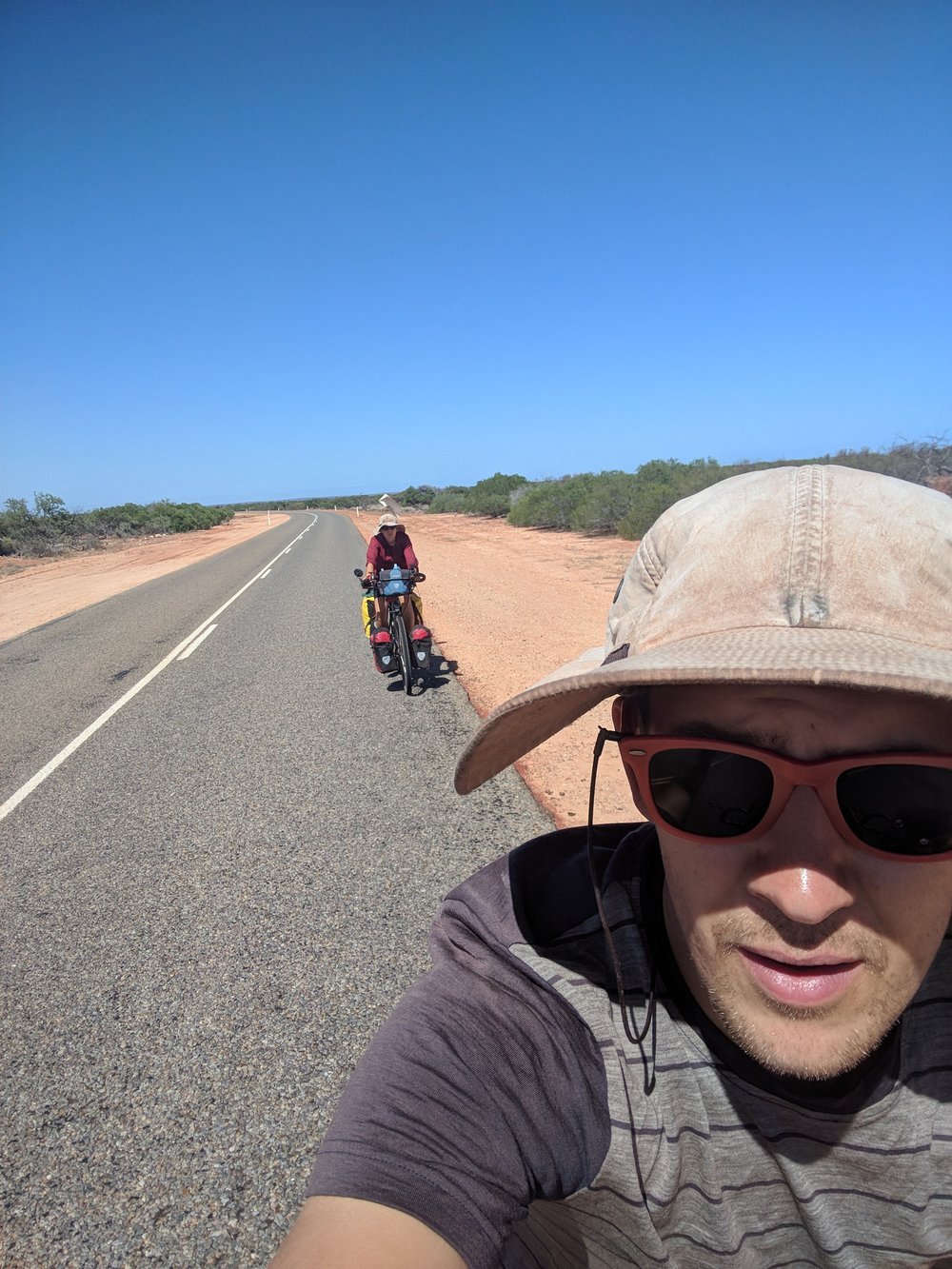
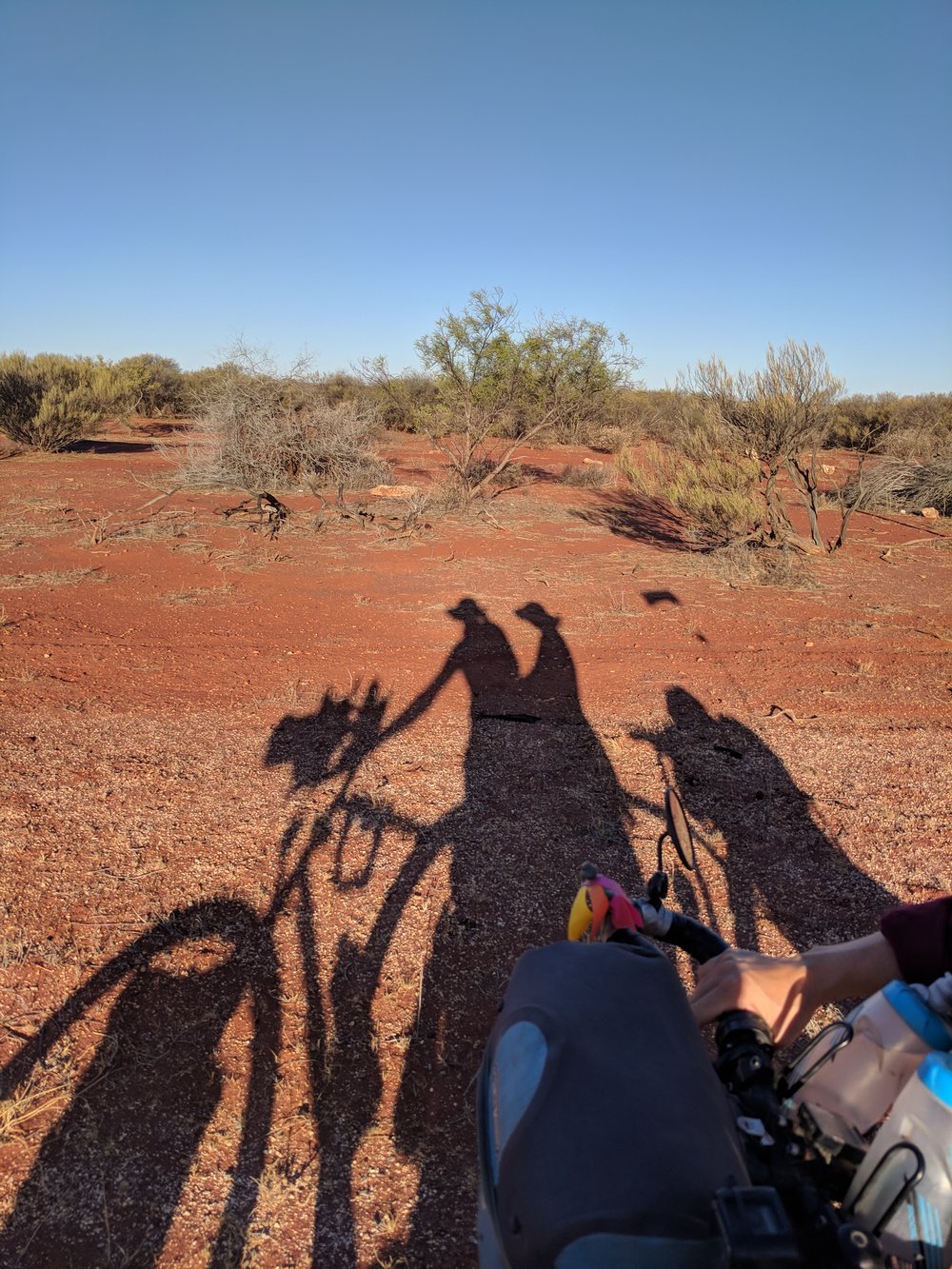
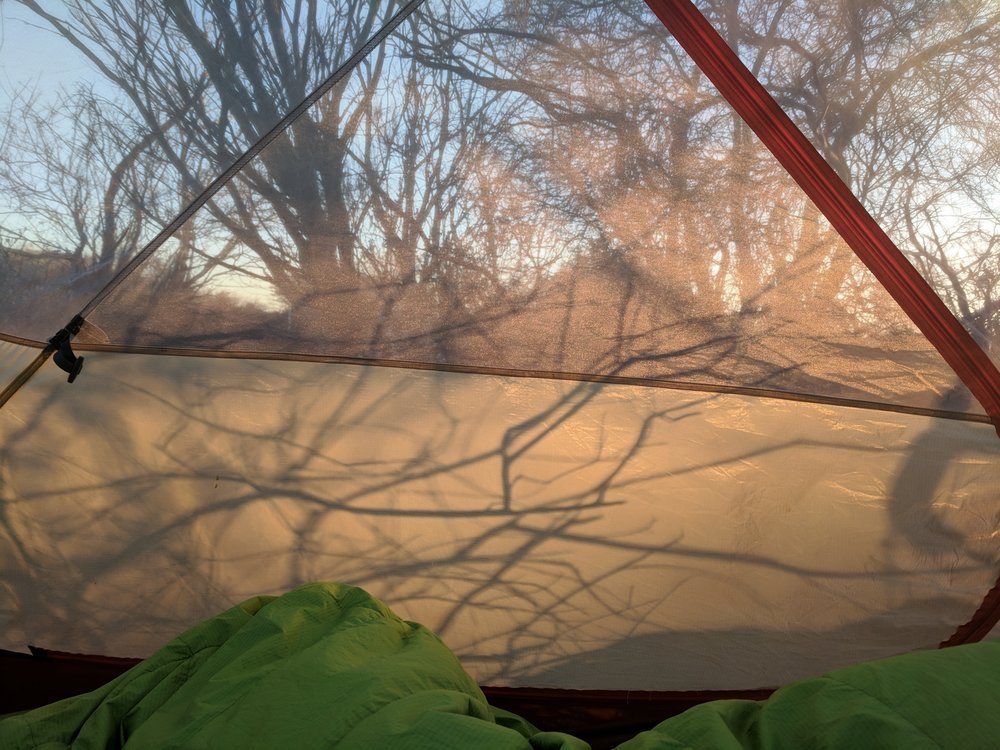

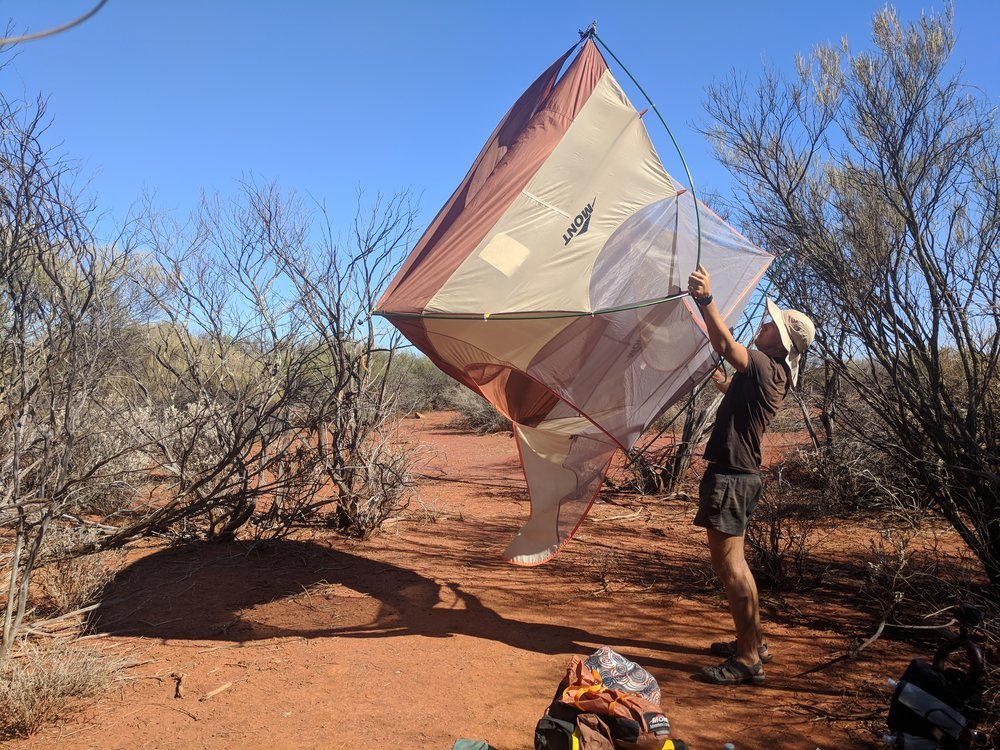
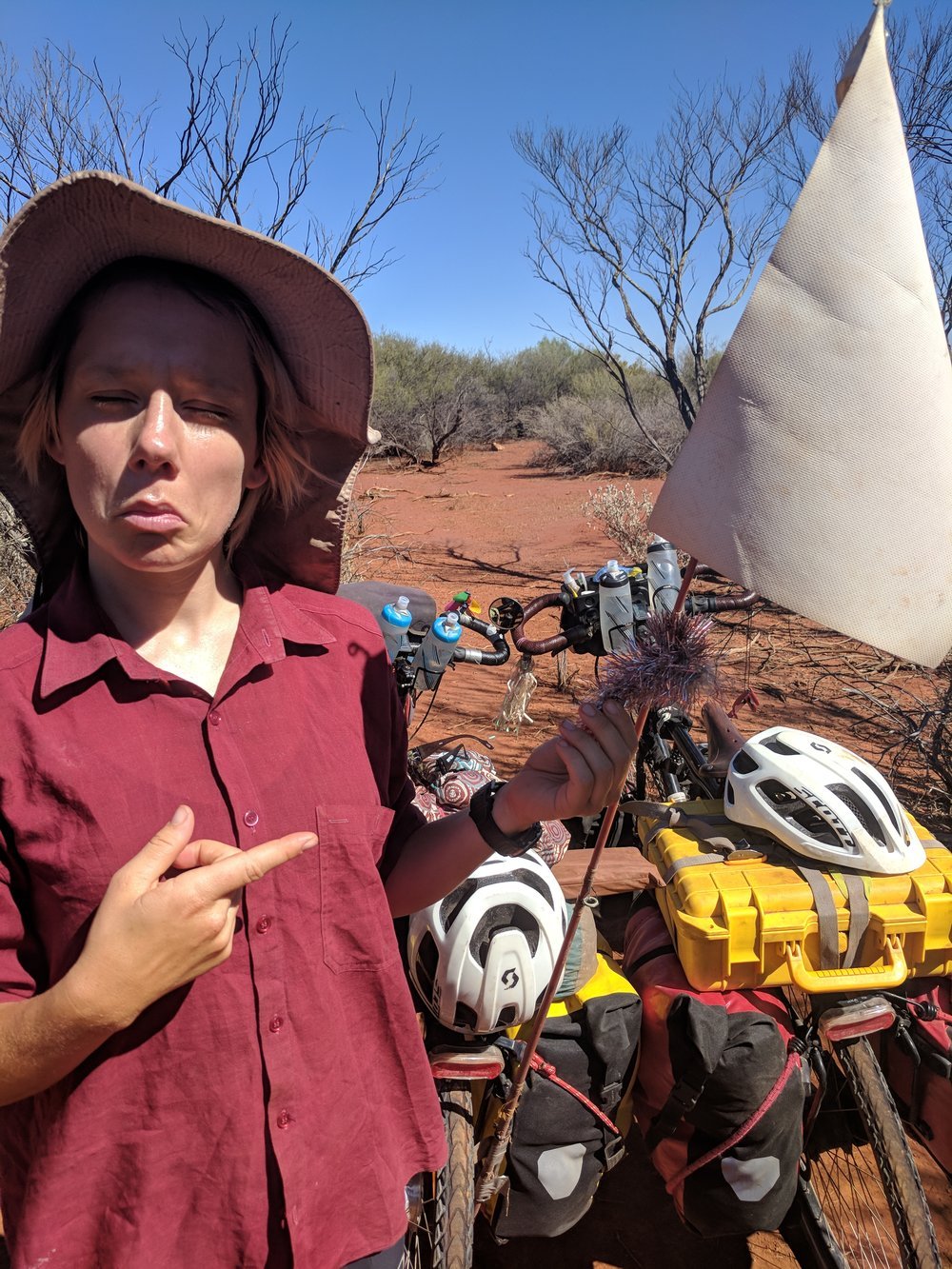
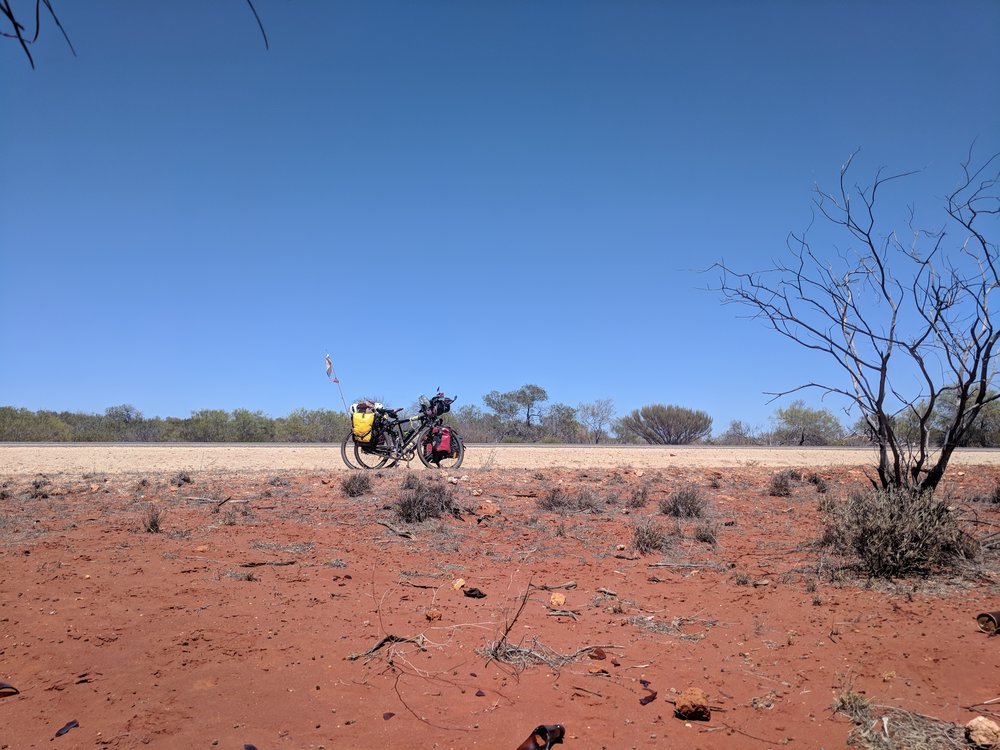


Cheers,
Dusty/Sandy & Thirsty
dited by the lovely Jen Richards
P.S; Who is she!? On that horrid stretch out of Fraser Island back at the start in February, two incredible people Kaz & Dave were waiting for the Wanggoolba Ferry as well. They gave us chairs, cold water, snacks and good conversation over the three hours and it turned out they too were from Singleton (Bobbie’s home town)!!
That evening, making it over to Hervey Bay we received a lovely email from Jen, who is the mother of Dave from the ferry. She gave us great encouragement and picked up some spelling errors in our very first blog, of course considering she is a retired Business teacher. Jen sadly had to retire due to a stroke in 2011 but has a passion for learning about Australian history and so, much to our luck offered herself as our blog editor to keep her brain as active as possible in an attempt to combat her high risk of suffering dementia following her brain damage. We write our blogs when we’re back in reception, send them off to Jen and within a quick turnaround she has them back to us, edited. We send through research requests at times for our next stops and she delivers the goods tenfold. An amazing woman and we are so grateful for her contribution to The Grand Section. Thanks Jen, you’re a bloody legend!




